- Privacy Policy

- Houseplants
- Gardening And Landscaping

Wandering Jew Plant (Tradescantia or Spiderwort): Care, Types, Images and More
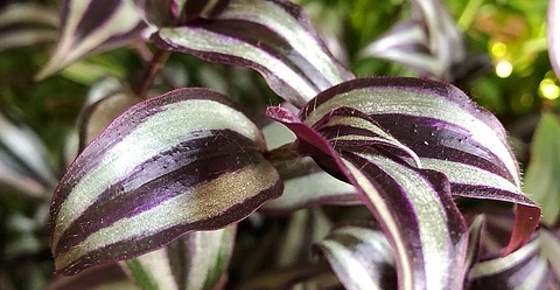
The wandering Jew plant is a common name for different species of plants that belong to the Tradescantia genus. There are around 75 different types of plants in Tradescantia genus and some are called inch plants, spiderwort, striped wandering Jew, Boat Lily, Purple Queen, or flowering inch plant. Wandering Jew plants are great house plants because they are relatively easy to care for. They are also easy to grow because the wandering Jew plant propagates easily from cuttings.
Some types of wandering Jew plants have green and gold leaves, some have reddish leaves, and others have green fuzzy leaves. There are also types of wandering Jew plants that flower. Depending on the species, the wandering Jew plant could have purple, white, or pink flowers.
How to care for wandering Jew plant : For the Tradescantia or spiderwort plant to thrive, grow in a plenty of indirect light and plant in fertile, moist potting soil with good drainage. Make sure the soil isn’t too dry or too damp and keep medium humidity levels. The ideal temperature range is between 65°F (18°C) and 75°F (23°C). You can fertilize every four weeks during the growing season with a diluted liquid houseplant fertilizer.
In this article, you will find all you need to know about this delightful houseplant. You will also get tips and ideas on how to care for your wandering Jew plants.
Wandering Jew Plant (Tradescantia or Spiderwort) – Overview of the Plant and Its Flowers
The botanical name for wandering Jew plant is Tradescantia zebrina and is also called the inch plant. However, the name wandering Jew is given to many herbaceous perennial plants in the Tradescantia genus. ( 1 )
Species of Tradescantias naturally grow outdoors in countries in Asia, Africa, Central and South America, and Australia. Varieties of wandering Jew plants also thrive well indoors, where, like their garden varieties, they grow well when it is warm, sunny, and moderately humid.
According to the United States Department of Agriculture, various varieties of Tradescantias are regarded as invasive plants in the wild. However, it is the fast-growing nature of spiderworts, wandering Jews, and inch plants that makes them perfect houseplants. ( 2 )
Many people like to grow wandering Jews or spiderworts in hanging baskets or grow them in pots to decorate a garden.
What does a wandering Jew look like?
Plants from the Tradescantia varieties have leaves that seem to grow in all directions (hence the term “wandering Jew”).
One of the distinct features about foliage on wandering Jews is that many of them have striped leaves. Sometimes, the leaves can be purple and silver stripes, whereas other types of Tradescantias have leaves that are almost all silver. ( 3 )
You may also notice that some varieties of wandering Jew plant have different colors on the underneath of the leaf. For example, the Tradescantia zebrina has green/silver leaves on the upper side and deep red or burgundy colors on the underside.
Wandering Jew flower
Wandering Jew houseplants also produce attractive flowers. These flowers can sometimes be white or can range in color from pink to various shades of lilac and purple. ( 3 )
However, plant lovers don’t usually grow wandering Jews indoors or outdoors for their blooms. It’s the beautiful variation of leaf colors that makes various types of Tradescantias so desirable houseplants.
Types of Wandering Jew (Spiderwort) Plants
The most popular types of Tradescantia plants to keep indoors are Tradescantia fluminensis ( spiderwort ), Tradescantia pallida ( purple heart ), and Tradescantia zebrina ( wandering Jew ).
Wandering Jew or inch plant ( Tradescantia zebrina )
This type of wandering Jew houseplant has purple and green leaves with a stripe pattern that resembles zebra’s stripes. There are types of wandering Jews that have bluish green leaves and purple hues on the underside.
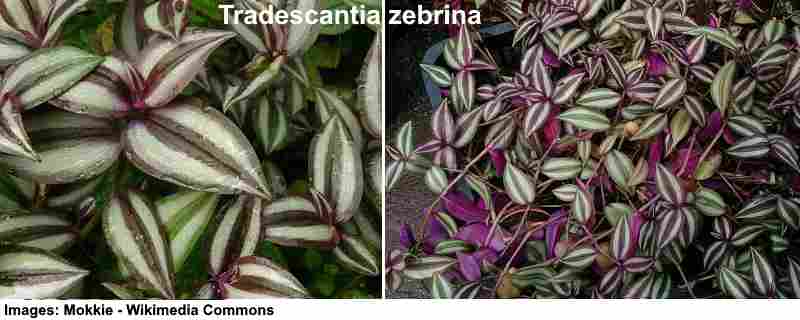
Tradescantia fluminensis (spiderwort)
There are a number of types of Tradescantia that are called spiderwort. This is distinguished from some Tradescantias as it has ovel shiny dark green leaves with pointed tips which are slightly fleshy .
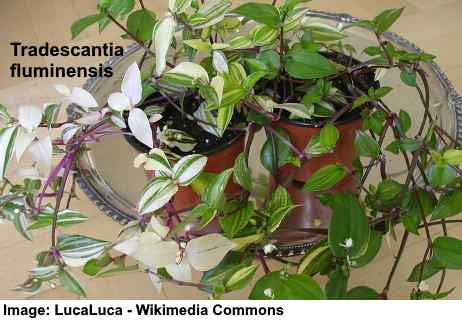
Picture of wandering Jew plant with white flowers
Tradescantia pallida (purple heart)
This type of spiderwort plant is also commonly referred to as wandering Jew. The T. pallida houseplants have vibrant purple leaves and light pink flowers when they bloom.
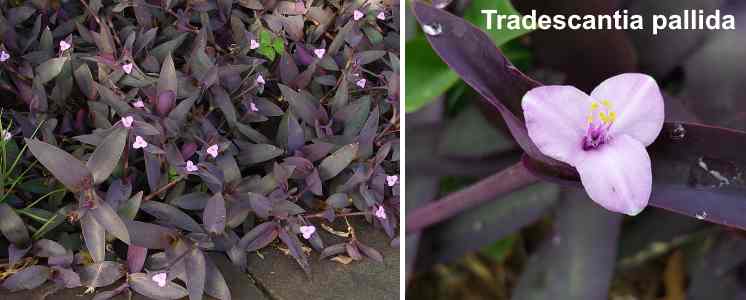
Wandering jew plant with deep purple leaves and light purplish-pink flowers
Tradescantia callisia
The leaves of T. callisia varieties are sometimes referred to as creeping inch plants. They have remarkably stripy leaves made up of green and white stripes.
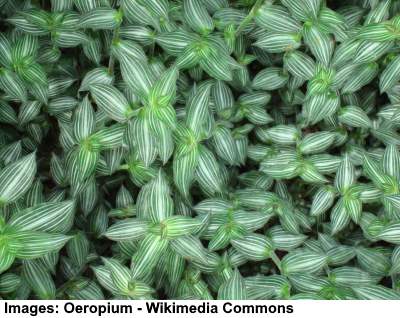
Picture of green wandering jew
Wandering Jew Plant Care (How to Grow Spiderwort or Tradescantia)
Caring for wandering Jew plants is fairly simple and straightforward. All plants in the Tradescantia genus enjoy moist soil, sunny but indirect sunlight, and warm conditions.
So, it doesn’t matter if you have fuzzy leaf Tradescantias, purple queen varieties, spiderworts, or wandering Jews, they all require the same type of care.
Light requirements for Tradescantias
To make sure that wandering Jew plants grow successfully, they require a good amount of light. This ensures that they grow with healthy leaves that have a vibrant green, silver, purple, or lilac colors.
The best place to place wandering Jew plant or spiderworts is in an east- or west-facing location. This means that they get plenty of natural light without being in direct sunlight when the sun is at its strongest.
The only exception is if you have Tradescantia pallida plants with dark purples leaves. They usually thrive in direct sunlight, although you should regularly check them in the summertime to make sure the sun isn’t too strong.
One sign that your Tradescantia isn’t getting enough light is if the color of their leaves starts to fade.
Best growing temperature for Spiderwort or Tradescantia
One of the reasons why wandering Jew plants are good for the home is that they thrive in room temperature.
The best temperatures for growing any type of Tradescantia plant is between 65°F (18°C) and 75°F (23°C). The houseplants also thrive in conditions that are described as “average humidity.”
If you grow Tradescantias outdoors, you should be aware of a drop in night temperatures and lower temperatures during winter. You should bring Tradescantias indoors if the temperature drops.
Best watering techniques for wandering Jew plant care
To care for your inch plant, spiderwort, or wandering Jew, you should keep the soil moist.
The best way to water a wandering Jew is to water the soil thoroughly and let the water drain out the bottom. Another way to water your purple house plant is to put water in the plant pot tray and allow the plant to soak up as much as it needs.
Some beginners who start caring for houseplants such as Tradescantias for the first time buy a soil moisture gauge to help get the soil moisture levels just right.
When it comes to proper watering for your wandering Jew, always make sure the soil isn’t too dry or too damp. Usually, weekly watering in the summertime is enough to keep your Tradescantia growing well.
The best fertilizer for wandering Jew houseplants
The reason why Tradescantias are so easy to care for is that they don’t usually require any feeding.
If you decide to encourage your inch plant or spiderwort to grow faster, then choose a liquid organic fertilizer mixed at half strength and use once a month.
Most houseplant growers don’t feed their wandering Jew plants in the fall or winter as they tend to become “leggy” or “straggly.”
Which type of soil to use for Tradescantias
To properly care for wandering Jew varieties of houseplants, you only need to plant them in regular potting soil.
How to prune wandering Jew plants
In time, Tradescantia plants require some cutting back and pruning. This helps to give your houseplant a bushier appearance and also gives you plenty of cuttings to propagate.
For Tradescantia pruning, you just need to pinch off the stem tips to leave about ¾ of the length. This will encourage your plant to grow better and become more attractive.
Growing Plants from Wandering Jew Cuttings
Even for the most novice of houseplant owners, propagating any type of Tradescantia plant is very easy. After you have cut back your “leggy” wandering Jew stems, you will have a large number of cuttings that you can use to grow new house plants.
How to propagate wandering Jew plant leaves
To prepare your wandering Jew cuttings or purple heart plant cuttings for propagation, you need a couple of stems about 1-2 inches long. Remove all the leaves apart from 2 or 3 at the end of the stem.
There are 2 ways you can grow wandering Jew plants from cutting:
- The first way is to just put a cutting in potting soil and wait for it to grow. All you have to do is make sure that the soil is kept moist and not overly damp.
- The other way to grow a Tradescantia from a cutting is to put the stem in water. You should notice that new roots start to grow within a week. When you notice new roots growing, you can transfer your cuttings to a pot to grow a new houseplant.
Wandering Jew Outdoor Plant Care
Tradescantia plants are great garden plants and grow well outdoors in warmer zones in the U.S. (USDA growing zones 9-11). In fact, it is because they grow so well outside in warmer countries and are quite invasive that they are classed as a weed in certain countries.
You can easily care for any Tradescantia plants to add color and beauty to your garden. Purple hanging plants or wandering Jew vines with stripy leaves can grace any patio, doorway, or garden area.
As with caring for wandering Jews or spiderworts indoors, Tradescantia plants growing outdoor should be protected from direct sunlight. So, place your plants in shady areas of the garden. But it’s good to remember that some bright light will help the wandering Jew plant produce more flowers.
Temperature
Also, frost can damage the plant, so, if you live in areas where fall and winter temperatures drop below 10°F (12°C), you should take them indoor and continue to grow them as houseplants.
Problems with Wandering Jew Plant (Spiderwort)
Even though it is relatively easy to care for wandering Jew plants, you can still come across certain problems.
Let’s look at some growing tips for Tradescantia plants to avoid or remedy some common problems.
The most common pest when growing wandering Jews indoors are bugs such as spider mites or aphids . The appearance of these pests on your bushy spiderwort or inch plant may be a sign that conditions are too dry.
To help remedy the problems of pests on your Tradescantia, mist the leaves regularly and make sure the soil is moist enough. You may need to wash off the mites with water to help get rid of the infestation.
One of the beauties about caring for wandering Jew plants indoors or outdoors is that they are not susceptible to disease. Usually, any discoloration of the leaves or poor growth is connected to the soil being too dry or too damp.
Fungal infections
Overwatering spiderworts, inch plants, or wandering Jews can cause a fungal growth called botrytis to develop in the roots.
Brown leaves
As with most problems associated with caring for Tradescantias, brown leaves can also indicate that the growing environment isn’t right. The leaves of your wandering Jew could have turned brown because of too much or too little sunlight. Also, too much watering can affect leaf health.
Where to Buy Wandering Jew Plants
Many garden centers and online stores stock many different varieties of wandering Jews. You will also find that Tradescantia cuttings are available online.
Because many different types of wandering Jews are so easy to grow yourself, you could ask a friend for a cutting if they have the plant. You can also get more Tradescantia houseplant or garden plants by propagating cuttings from plants you already have.
FAQ Related to Wandering Jew Plant (Tradescantia)
Do they need any pruning.
To properly care for wandering Jews, the leaves and stems require pruning. The stems can grow quite long and start losing their leaves from the base. The best time to prune any Tradescantia plant is just before the growing season in late winter or early spring.
You may also find that Tradescantias grow better if you give them a mild prune in late summer.
How to prevent wandering Jew roots from rotting?
Go easy on the watering to stop Tradescantia plants’ roots from rotting. Water them enough to keep the soil moist during summertime and only occasionally in the winter.
Are wandering Jew plant leaves toxic to animals?
While not toxic to cats or dogs, the leaves of wandering Jew plants can cause irritation. If you have pets that like to nibble on leaves, you can still benefit from the beauty of Tradescantias if you grow the outdoor plant in hanging baskets.
Can I grow my Tradescantia plant outdoors?
Yes, you certainly can. Wandering Jew plants grow well out of doors in warm climates. During the summertime, you can move your indoor houseplants to the garden and place them away from direct sunlight.
Dashes of purple colors, bright pinks, or interesting green and purple stripped leaves can make an interesting feature in any garden or balcony.
Can you train a wandering Jew plant?
Tradescantia plants are easy to train because their stems can grow very long and you can wrap them around objects. Wandering Jew plant stems can grow up on trellises or obelisks or up around any other item.
Heavily pruning wandering Jews in late winter can also help to train the plant to grow into a colorful bush.
How fast does wandering Jew plant grow?
Tradescantia cuttings should start growing roots within a week or so. Once the plant is established, you can expect it to grow about an inch every week. Some people claim this is the reason that some Tradescantias are called inch plants.
Can Tradescantia houseplants cause allergies?
The sap of wandering Jew plants or prolonged skin exposure to its leaves could cause allergic reactions.
The journal Allergy reports that indoor plants such as Tradescantia can also cause symptoms such as itching of the throat, swelling, wheezing, and runny eyes and nose. ( 4 )
Do wandering Jew varieties have any health benefits?
Although not widely used, extracts from Tradescantia zebrina have certain medicinal properties. You can buy inch plant herbal liquid extracts that are said to have many antioxidant properties.
Researchers have found that therapeutic compounds in Tradescantia extracts have antibacterial, anticancer, and antioxidant uses. ( 5 )
Related articles:
- Moses In Cradle Care: How to Grow Tradescantia spathacea
- Chinese Money Plant Care: How to Grow Pilea Peperomioides
- Dracaena Marginata Plant Care: How to Grow Madagascar Dragon Tree
- Growing Houseplants
- Indoor Garden Ideas
- Cactus & Succulents
- Houseplants Care
- Flowers & Blooms
- Gardening Guide
- Plant Care and Tips
- Beans/Fruit Vegetables
- Companion Planting
- Culinary Herbs
- Flowering Herbs
- Garden Design
- Gardening Ideas
- Growing food
- Growing Trees and Shrubs
- Leafy Vegetables
- Medicinal Herbs
- Patio Gardening
- Root Vegetables
- Shade Plants
- Temperate Fruits
- Tropical Fruits
- Balcony Gardening
- Container Fruits
- Container Gardening Ideas
- Container Herbs
- Container Vegetables
- Rooftop/Terrace Gardening
- Urban Gardening
- Vertical Gardening
- More Than Gardening
- Best and Top of Gardening

- Container Gardening
- Indoor Gardening
8 Types of Wandering Jew Plants+Care Tips

2-Minute Read
When it comes to versatility, there’s none like the adaptable wandering jews check all different types of wandering jew plants in this detailed article.
Wandering Jew Plant comprises various species in the Tradescantia genus. As the plant is adaptable to both indoor and outdoor conditions, it doesn’t matter if you are planning to have it as ground cover, in hanging baskets, or in containers; it’ll do equally well! Also, d o you know you can grow wandering jew in the complete shade, as well as in full sunlight? In full sun, it looks more colorful. Whereas, shade gives its leaves a greenish hue. Here are the Types of Wandering Jew Plants you should consider growing!
Have a look at the plants you can start with just one cutting and a glass of water here
1. tradescantia fluminensis.

It’s a popular indoor houseplant, which is also used as ground cover. Its white flowers are triangular and formed by three petals and look glorious attached to fleshy stems with oval-shaped leaves that are glossy and deep green.
Check out our article on colorful houseplants here !
2. tradescantia zebrina.
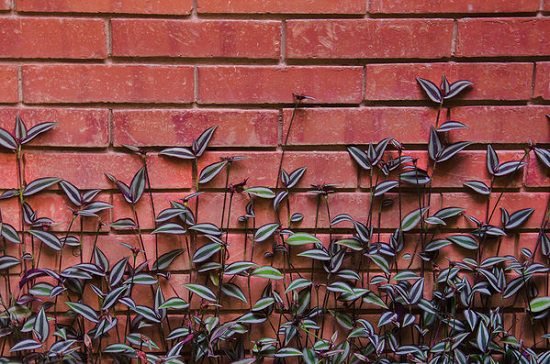
The variegated leaves resemble the stripes of the zebra, hence the name! The purplish-green foliage has a silver outer edge and white stripes running down lengthwise. It grows low to a height of 6-12 inches, and that’s why it can be grown as ground cover. It is one of the best types of wandering jew plants on the list.
3. Tradescantia pallida

It also goes by the name “Purple Heart” and is native to Mexico. Deep purple foliage, adorned with light purplish-pink flowers, looks marvelous and is the reason that it’s one of the most popular types of wandering jew plants! Apart from growing it as a striking ground cover, you can also have it in hanging baskets.
To know about more purple houseplants, click here !
4. tradescantia blossfeldiana.

Commonly known as the ‘Inch plant,’ it’s also referred to as Tradescantia cerinthoidebs . The thick green leaves have a fuzzy texture and a purple hue on the underside. You can easily propagate it from the cuttings, both in soil and water, once it gets growing. It bears delightful clusters of blue, purple, white, or rose pink flowers, making it one of the best types of wandering jew plants on the list.
5. Tradescantia Sillamontana

If precise geometric patterns are your thing, then you’ll love it because of its foliage. Growing from a thick succulent stem, the leaves are around two inches long and covered entirely in white hair. Magneta flower protrudes from the terminal end of the stem in summers.
6. Tradescantia spathacea
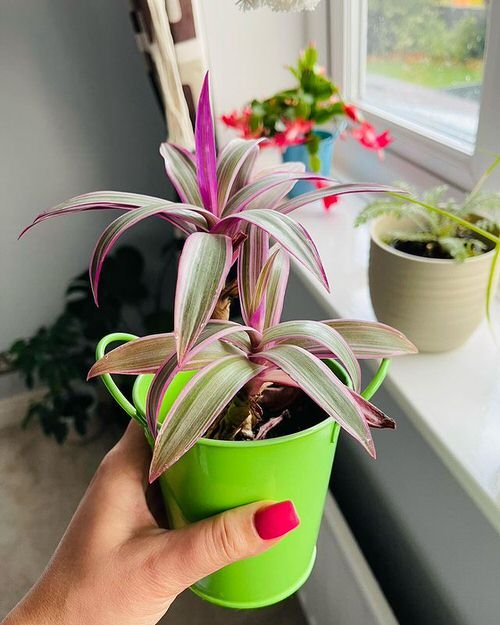
Known as Moses-in-a-basket, Oyster plant, or Boat lily, it is a sub-succulent herb from southern Mexico, Guatemala, and Belize. It grows in 6-12 inches long rosette and sword-like, narrow, and spiral-shaped dark green leaves, with purple bottom sides. The white flowers are enclosed with boat-like purple bracts, hence the name.
7. Tradescantia virginiana

Commonly known as the spider lily, it is a herbaceous perennial from the Commelinaceae family. The plant produces violet-purple to blue, three-petaled flowers, with yellow stamens and dark green arching leaves. You can grow this one of the most popular types of wandering jew plants under full to partial shade.
8. Tradescantia longipes
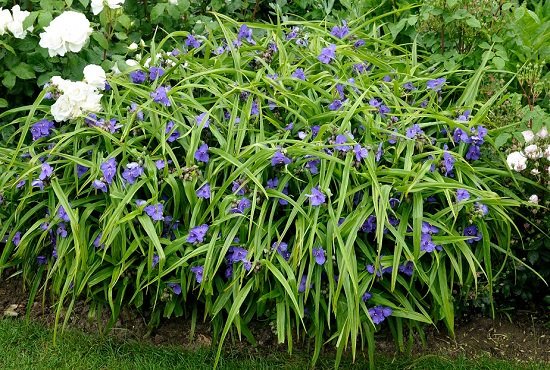
Adorn your garden by growing beautiful, purple-blue flowers of tradescantia longipes or spiderwort. It is native to Southern Missouri and northern Arkansas from the family Commelinaceae. Grow these three-petaled flowers for rock or naturalize gardens, in partial shade, by using well-drained, moist, acidic soil, making it one of the most popular types of wandering jew plants on the list!
Check out our article on indoor rock garden ideas here !
Wandering jew plant care tips.
- Grow a wandering jew plant in bright, indirect light or expose it to full sun, which it won’t mind either. Just keep in mind that low light can fade the markings on leaves.
- Water the plant directly around the roots, avoiding the crown, as it can result in rot.
- The plant prefers slightly moist soil, so maintain the right watering schedule.
- Use an all-purpose, water-soluble fertilizer, once a month, during the growing period.
Recent Posts
10 orchids that look like animals, everything about making a chaotic garden, 11 best colocasia varieties to grow indoors, 8 plants that look like marijuana, 10 high maintenance plants for gardeners who like challenges, 13 plants that look like dandelion leaves, 26 companion plants for roses to keep pests away, how to grow a snake plant outside for landscaping, join our 3 million followers:, related articles, grow big, bushy, and lush hostas with epsom salt: 4 best uses, how to grow night blooming jasmine indoors: the most fragrant flower, 24 trendy snake plant arrangements for 2024, why everyone should have a spider plant at home: 8 reasons, how to grow cilantro indoors easily, how to make ponytail palm grow taller and large: 6 tricks.
dO YOU NEED TO BRING A POTTED PLANT INDOORS DURING THE WINTER MONTHS?
Depends on the plant and where you live. Do research on the specific plant.
Sooooo number 4…. Is not a blossefeldiana. It’s a flumensis. …. You posted a tri-color-mundula variegata……. Not a nanouk. A nanouk is a blossefeldiana centerthoides
LEAVE A REPLY Cancel reply
Save my name, email, and website in this browser for the next time I comment.

Get the Best of BalconyGardenWeb Directly in your inbox.
POPULAR CATEGORY
- Best and Top of Gardening 1587
- Flowers & Blooms 636
- Growing Houseplants 599
- Gardening Guide 413
- Gardening Ideas 381
© 2023 Balcony Garden Web | All rights reserved
- Privacy Policy
- Terms of Service
- Feedback Page

Wandering Jew Plant (Tradescantia zebrina): Types, How to Grow and Care
Sharing is caring!
Plants with trailing and creeping habits are some of the best plants to keep. They are fast-growing and make thick carpet of groundcovers for gardens in no time and they also create striking hanging indoor plants.
Among the all-time best trailers to grow is the wandering jew. Easy to maintain and drapes beautifully, this colored plant will make any space more inviting and interesting.
Medicinal Properties
Propagation and maintenance, what is a wandering jew plant.
Tradescantia is one of the 37 genera under the plant family Commelinaceae (1). Some of its 75 species are commonly called ‘wandering jew’ (also known as inch plant), a name they adapted due to their long lifespan like the Jewish character from a Christian folklore.
Another name for this group of herbaceous perennial plants is ‘spiderwort’ after the spiderweb-like sap they produce when the stem breaks. They are native to Canada, Mexico, and Argentina and have been naturalized in other parts of the world (2).
The most common tradescantia grown ornamentally is the T. zebrina also previously called Zebrina pendula . It has long fleshy stems where the wandering jew plant leaves and roots appear. The lance-like leaves are a mixture of green and purple with silver stripes on the upper side and deep purple under (3). The plant grows close to the ground and can only reach 20 to 30 cm high.
Does Tradescantia Zebrina Flower?
The wandering jew is considered an ornamental plant primarily because of its showy colorful foliage but the plant does produce pink flowers.
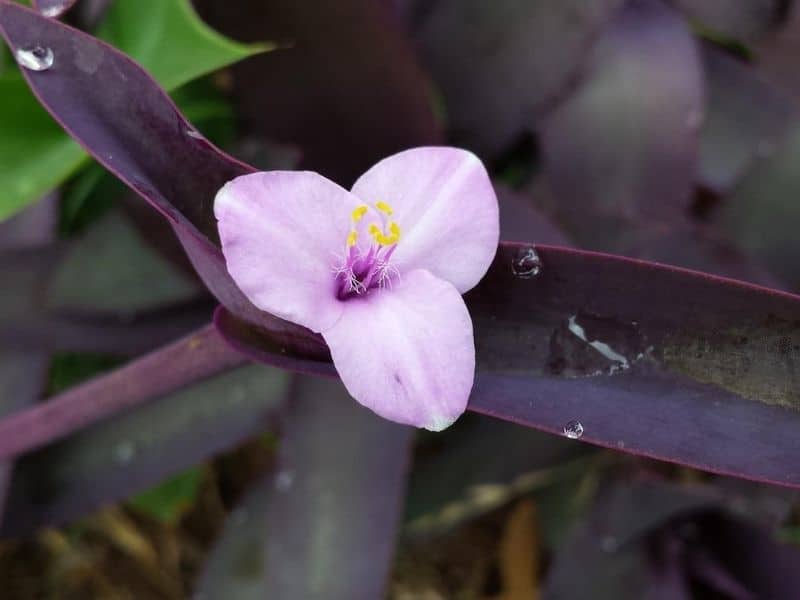
Small three-petaled pinkish purple flowers appear sporadically throughout the year (4). The resulting fruit is a capsule containing tiny brown seeds.
Is it Toxic to Pets?
Spiderworts are normally harmless plants but they contain toxic properties that may cause mild gastric problems and dermatitis to pets. Although they don’t lead to anything serious, it will be safe to keep the plants out of reach of pets and to keep the hands protected when dealing with the sap of the plant.
Because of the plant’s hardiness and adaptability to different environments, the wandering jew establishes well, in fact so well that it can be considered an invasive species. In countries like Australia, the plant has the capacity to invade natural vegetation. Although growing them is not prohibited, everyone is obliged to keep the plant’s growth under control (5).
Studies showed that Tradescantia has significant effects as an anticancer, antioxidant, and antibacterial medicinal plant. In traditional Chinese medicine, the wandering jew plant is highly valued as treatment for kidney failure.
The extract from the whole plant is cooked with dates, ginger, and water and consumed by patients. The plant is also known to treat high blood pressure, cough, urinary tract infection and tuberculosis (1).
How to Grow and Care for a Tradescantia
Here’s how to care for a wandering jew plant, one of the easy house plants to own.
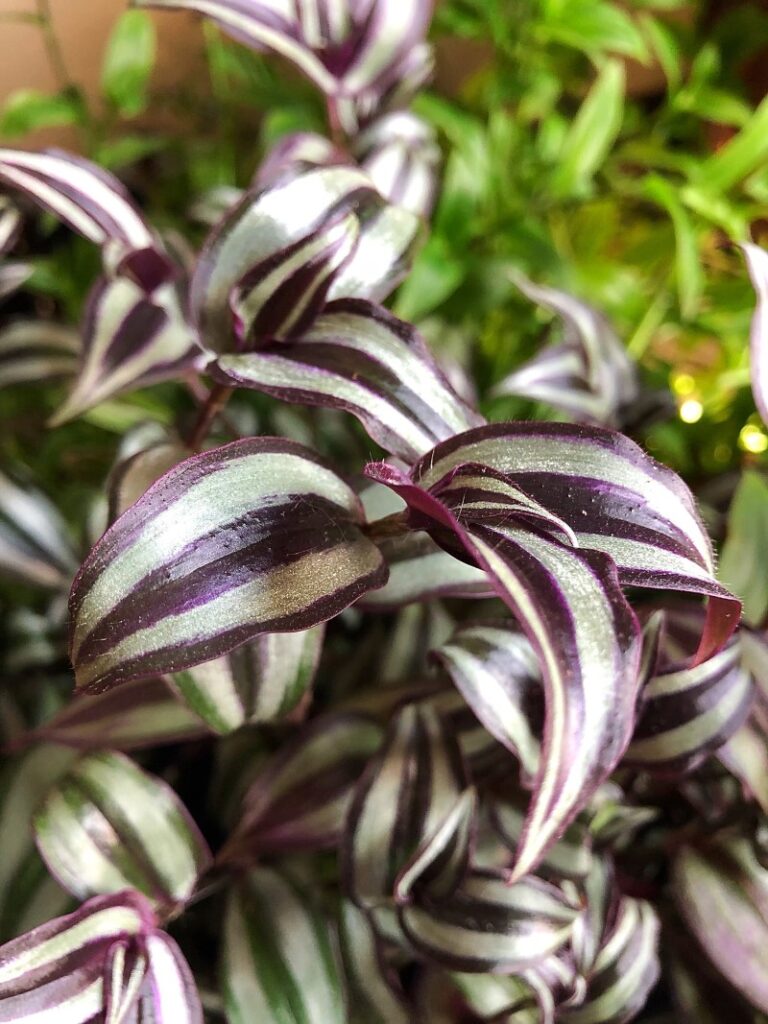
Light and Water
In the wild, the wandering jew plant thrives without assistance but under the right conditions. It likes filtered sun so indoor fluorescent light is enough. Placing them by the window and turning the plant every two weeks will keep the leaves colorful and the growth even on all sides (3).
The plant spreads easily in damp areas that’s why it naturally grows along riverbanks and roadsides. When potted, the soil should be kept moist but well-drained. Saturated soil often causes root rot.
Fertilize your Tradescantia plant once a month during the growing season (spring and summer) with a balanced, water-soluble fertilizer diluted to half strength. Avoid fertilizing in fall and winter when the plant is dormant. Over-fertilizing can lead to fertilizer burn and damage the plant, so follow the instructions on the fertilizer package carefully.
Temperature and Humidity
Spiderworts like it warm but there should be enough air circulation or else the leaves will sag. During the heat of the summer, taking the plant outside under shade will provide the necessary cool to the plant.
Mist the hanging plant early in the morning and late in the afternoon. If the plant is on a table, place a glass of water beneath the leaves or put the pot on a wet pebble tray. This will humidify the immediate vicinity of the plant aiding in its photosynthesis and transpiration processes.
Pests and Diseases
The most common living enemies of the wandering jew are aphids, mealybugs, scale, white flies, and spider mites. Manual removal at the onset of infestation is effective but they should be closely monitored as serious attack may lead to the plant’s death. If left unnoticed and the infestation has become severe, get rid of the plant by burning to avoid contamination.
Since the creeping inch plant is mainly soft almost like a succulent, soggy soil and too wet conditions lead to root and stem rot (4). As long as the plant is receiving just enough moisture, this disease will be avoided.
Propagating wandering jew plants is very easy. They can grow from seeds but will take years to establish so the more convenient stem cutting is best. The trailing or creeping stems form nodules where the roots will eventually grow as it comes in contact with the potting soil (2). When the hanging plant has longer trails than intended, it can be trimmed and the resulting stem cuttings can be rooted to form new plants.
There will be times that the potted wandering jew will become leggy, especially if it’s been receiving more shade. To promote a bushier growth pinch back by literally pinching the tip of the plant where the new growth occurs (4). This practice allows the formation of lateral stems.
In two or three years, these hardy plants may become pot bound, with the roots taking up most of the space in the pot. Repot in a larger container with a good mixture of soil, coarse sand, and compost to replenish the nutrients and provide room for the roots to breathe. Additionally, fertilize once every two months by foliar application just to improve plant vigor.
Common Varieties of Wandering Jew
The oldest and most common indoor wandering jew, this species has leaves alternating, often overlapping when young, purple leaves with silvery green thick stripes and solid purple underside. The stem is also a mixture of purple and green.
T. blossfeldiana
The leaves of this species are quite thicker, glossy, and covered in miniscule hairs called trichomes. The three-petalled flower is an ombre of white and pinkish purple with yellow anthers.
T. fluminensis ‘Tricolor’
This attractive variety showcases leaves with white, lilac, and green variegation. It appears smaller than the common wandering jew but bushier in form.
T. sillamontana
This whimsical species looks frosted with its silvery trichomes covering the entire plant. The green leaves are still alternately arranged but more compact which make a potted plant look more bushy than trailing. The light color of the leaves provide a complementing backdrop to the bright purple flowers.
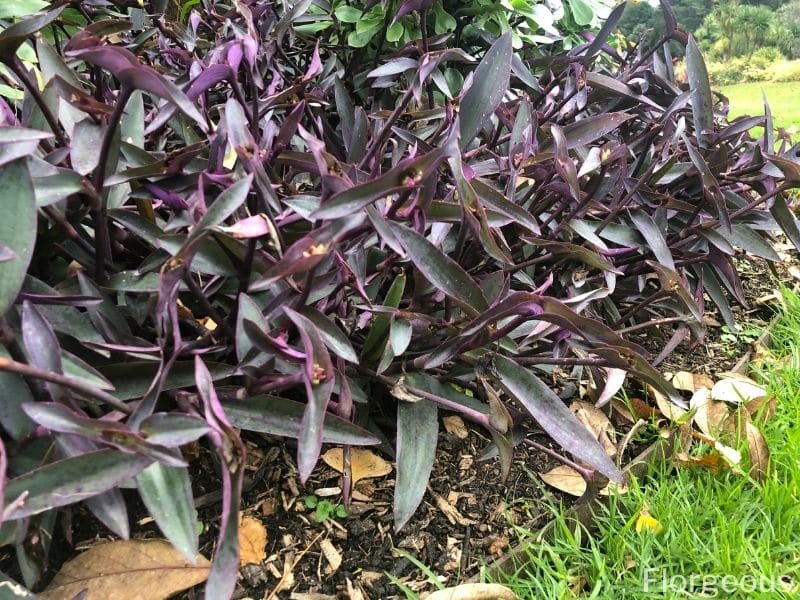
The leaves and stems of this species are in striking deep purple color hence the common name ‘ purple heart ’. Under shaded, they turn a hint of dull green. The leaves are also longer and have wider space in between.
Does Wandering Jew plant need full sun?
Wandering Jew plants (Tradescantia zebrina) prefer bright indirect light but can tolerate some direct sun, especially in the morning or late afternoon. However, prolonged exposure to intense sunlight may cause their dark green leaves to scorch.
How do you care for a wandering Jew plant indoors?
To care for a Wandering Jew plant indoors, place it in a location with bright, indirect sunlight, such as near a window. Water it when the top inch of soil feels dry, typically every 1-2 weeks, and provide well-draining soil. Additionally, mist the plant occasionally to increase humidity and remove dust from the leaves.
How do I make my Wandering Jew fuller?
To make your Wandering Jew plant fuller, prune it regularly to encourage branching and bushier growth. Pinch off the tips of the stems or trim back leggy growth to promote new growth and create a more compact appearance. You can also propagate wandering jew cuttings to create new plants and fill out the pot.
How long do Wandering Jew plants live?
Wandering Jew plants are generally long-lived when provided with proper care. With the right growing conditions indoors, they can thrive for several years, often becoming fuller and more lush over time with regular pruning and maintenance.
Reference List
(1) Dash, G., et. al. Tradescantia zebrina: A Promising Medicinal Plant. 2017. IAJPS, 4 (10). P. 3498-3502 .
(2) Arakelyan, H. Tradescantia zebrina- Mother Nature Healing. 2019. Researchgate.
(3) Vermeulen, N. Encyclopedia of House Plants. Taylor and Francis. 1999. P. 320.
(4) North Carolina State Extension. Tradescantia zebrina. NC State University. 2018. https://plants.ces.ncsu.edu/plants/tradescantia-zebrina/ . Accessed on 12 August 2020.
(5) The State of Queensland. IPA-Zebrina. Department of Agriculture and Fisheries. 2020. https://www.daf.qld.gov.au/__data/assets/pdf_file/0020/51284/IPA-Zebrina-PP102.pdf . Accesed on 12 August 2020.
Photo by Wirestock/depositphotos
Have you seen these?
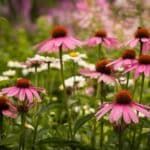
5 Best Coneflower Companion Plants and The Worst to Avoid
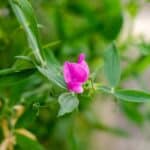
Enhance Blooms & Soil Health: Top 12 Companions for Sweet Peas
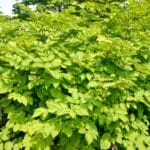
6 Best Aralia Sun King Companion Plants and Landscaping Ideas
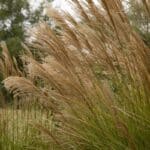
Growing and Caring for Maiden Grass (Miscanthus sinensis)

How to Grow and Care for Fountain Grass (Pennisetum)
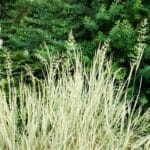
Growing and Caring for Blue Oat Grass (Helictotrichon sempervirens)
About the author.
Grow. Play. Every Day!

- House & Home
- Houseplants
Wandering Jew Care: How to Grow a Long and Luscious Inch Plant (Tradescantia Zebrina)
Tradescantia zebrina (commonly known as wandering Jew, spiderwort, or inch plant) is popular for a reason: This beginner-friendly houseplant is low-maintenance and grows quickly. It’s also super easy to propagate more plants so you can fill your home with more of the colorful striped foliage the species is known for.
Written by Linda Ly

When it comes to vigorous, colorful, and easy-to-grow hanging houseplants, there aren’t many that can compare to Tradescantia zebrina (known more commonly as wandering Jew—and I’ll touch on the history of that name below). Whether you’re a houseplant beginner or a veteran, most indoor gardeners have owned one of these potted plants at some point.
Keep reading for everything you need to know about Tradescantia zebrina and growing this stunning houseplant in your own home.
Disclosure: If you shop from my article or make a purchase through one of my links, I may receive commissions on some of the products I recommend.

About inch plants
Natural habitat.
Tradescantia zebrina is a native of Central and South America, from Mexico down to Colombia, as well as the Caribbean. Here, it forms part of the undergrowth in lightly forested and often very moist areas. It can form very dense, wide mats thanks to its creeping growth pattern and ability to throw roots extremely quickly.
Unfortunately, its vigorous growth has also made Tradescantia zebrina an invasive plant in some regions. This includes Hawaii, Brazil, and Australia, where the species easily takes hold in moist, forested areas.
As a 2019 study carried out in the Brazilian Atlantic Rainforest notes, this is problematic due to the species choking out native plants.
Some of the above was caused by careless gardeners allowing bits of the plant to get into the wild, where they quickly root. If you’d like to grow spiderworts like this one in your garden, please make sure to dispose properly of any trimmings left after pruning!
This also applies to zebrina’s popular cousins, like Tradescantia fluminensis, T. pallida, and T. spathacea.
Description
It’s not difficult to see why Tradescantia zebrina gained popularity as a houseplant. Wandering spiderwort plants (not to be confused with spider plants , another beginner-friendly species) are low-maintenance and grow just about anywhere—they even just grow in water !
Easy care and quick growth aside, spiderworts are also just good-looking plants. The pointed, oval leaves on thin, fleshy stems overlap slightly and are characterized by their zebra pattern in purple and silvery green. The leaf undersides are deep purple in color and the tiny, three-petaled flowers are bright pink.
Although this species is naturally a creeping plant, it’s often grown indoors in hanging planters. As long as the plant is provided with enough light, the foliage will be very dense and brightly colored, forming a spectacular waterfall that can reach more than 3 feet in length.
What’s in a name? In the case of common houseplants, sometimes a lot.
Tradescantia zebrina is a classic houseplant (I found mention of it in a 1964 German book about houseplants, but it’s probably been around longer than that!) and among most English speakers, it has long been known as wandering Jew. This is probably a reference to the “wandering” nature of the plant, as it does have a creeping growth pattern.
The legend of the wandering Jew is hundreds of years old and is now commonly considered to be rooted in antisemitism. It describes a Jewish man cursed to walk the planet until the Second Coming because he taunted Jesus on his way to the cross.
Because of this, the plant name has partly fallen out of fashion and has been the source of much debate in the plant world over the past few years.
Some plant enthusiasts have embraced the alternative “wandering dude,” which I personally think is a great option.
“Inch plant” (houseplant enthusiasts don’t agree on whether this refers to the fact that it can grow an inch a day, or that you only need an inch of stem to propagate it), “spiderwort,” or “wandering spiderwort” are also popular alternatives, though these are common names for other Tradescantia varieties, such as Tradescantia Nanouk.
The best way to avoid any confusion is to just stick to the scientific name.

Inch plant varieties
There are three subspecies of inch plant (wandering Jew): Tradescantia zebrina var. zebrina, var. flocculosa, and var. mollipila. Unsurprisingly, after it having been a popular houseplant for so many years, nurseries have also managed to create a whole bunch of cultivars through selective cultivation.
A few of the popular Tradescantia zebrina cultivars you may come across in your local plant store include, but are certainly not limited to:
- Tradescantia zebrina ‘Quadricolor’: Yep, as the name suggests, this one adds an extra color to the mix. The leaves are cream, pink-purple, light green, and dark green.
- Tradescantia zebrina ‘Burgundy’: Characterized by its very dark purple coloration.
- Tradescantia zebrina ‘Silver Plus’: Less purple, more shiny silver.
- Tradescantia zebrina ‘Red Gem’: Less silver, more intense (light) purple.
- Tradescantia zebrina ‘Purple Joy’: Less silver, more dark purple.
- Tradescantia zebrina ‘Tikal’: A rare, naturally occurring variety that collectors pay a pretty penny for.
Do keep in mind that most of these cultivars aren’t patented and the amount of mislabeling and variation within a cultivar are both huge. Just growing your wandering Jew in lower-light conditions can completely change the way it looks, so it’s not surprising that confusion sometimes reigns supreme.
Luckily, care is the same across all cultivars, so your best bet is to just enjoy your plant even if you’re not sure what Tradescantia variety you’re dealing with!
Where to buy wandering Jew plants:
- California Tropicals
- Daylily Nursery
- The Green Escape

Caring for an inch plant
Light and temperature.
It’s important to provide your Tradescantia zebrina with enough light. It’s tempting to use plants to brighten up dark, shaded spots in your home, but that just doesn’t work with this one: It loses its dense growth pattern and beautiful coloration in low light.
To prevent your wandering dude plant from growing sparse and green, place it near a window that gets bright indirect light. Some full sun isn’t a problem either, but do make sure you acclimate it gradually to a higher light location.
Temperature-wise, this species is a lot hardier than many of the tender tropicals we like to grow in our homes (like Anthurium andraeanum and Begonia maculata ).
Wandering dude plants can handle a very wide range of temps, making it perfect for those chillier windowsills that your other plants may not appreciate. Room temperature is ideal, but anything between 50°F to 85°F will keep them happy.
Water and humidity
Your Tradescantia zebrina will appreciate lightly moist soil. You can water a bit more during the summer months, when the plant is actively growing and needs a lot of moisture, and less during winter, when soil tends to take significantly longer to dry.
If you’re not sure whether it’s time to water your wandering Jew plant yet, you can always turn to the age-old trick of sticking a finger in the soil.
- If it still feels damp, wait a little longer, until the first inch or two has dried.
- If it feels bone dry, you’ve waited too long; you may also see limp leaves on your plant at this point. It’ll bounce back, but not always without lasting damage.
- If the soil feels wet, you watered too much and need to keep an eye out for root rot.
As for humidity, given its rather wet natural habitat, wandering Jew does appreciate higher air moisture levels. The great thing is, though, that it doesn’t demand it. As long as you keep its soil lightly moist and the air isn’t extremely dry, your plant should do well.
Soil and planting
Wandering Jew is not fussy about its potting mixture at all. I’ve grown it in pure houseplant potting soil with no additives. If you do want to take things to the next level, you can add some perlite and/or peat moss, although this is really not a must.
Most houseplant enthusiasts like to place their wandering Jew in a hanging planter so they can enjoy the look of the leaves cascading down. This is not a must, though. You can also emphasize the species’ creeping growth habit by filling up a large, shallow planter, growing it in a terrarium, or even keeping it in water on a semi-permanent basis.
Recommended products for wandering Jew plant care:
- FoxFarm Ocean Forest Potting Soil
- Espoma Organic Potting Mix
- Perfect Plants Organic Perlite
Fertilizing
Like most other houseplants, Tradescantia zebrina appreciates a bit of fertilizer during the growing season, which extends from spring to early fall. You can use a normal houseplant fertilizer according to the instructions on the bottle.
Don’t fertilize during the winter months unless your plant is growing well. It doesn’t need extra nutrients if it’s inactive.
Recommended fertilizers for wandering Jew plants:
- Houseplant Resource Center Liquid Fertilizer for Houseplants
- Instant Biologics Instant Plant Food (Fizzing Nutrient Tablets)
- Maxsea All-Purpose Seaweed Plant Food
Pruning
There’s a good chance you’ll have to prune your Tradescantia zebrina regularly, because as I mentioned, this is a very quick grower. It also roots very easily, so any trimmings can be replanted! I’ll describe how to do this in the section on propagation below.
Aside from stem trimming, you can remove any dead leaves, which are bound to pop up from time to time in very dense plants like this species.
Dividing or repotting
Inch plants don’t grow by producing plantlets at their base like many other houseplants (such as spider plants ) do. Instead, inch plants spread by rooting along the stems.
This means that division is not really the way to go; keeping these plants manageable is usually done through pruning. You can shape your plant by pinching off any long, leggy stems to create a fuller appearance and control its spread.
You’ll notice that Tradescantia really doesn’t mind being a bit cramped in its planter. Still, it’s a good idea to provide your plant with some fresh soil every year or two by repotting it.

Propagating an inch plant
If you’ve never propagated a houseplant before, this is truly one of the best species to start with. It’s known for rooting extremely quickly in both water and soil, meaning it’s easy to fill endless planters to keep or give away.
All you need to propagate your Tradescantia zebrina is a pair of clean scissors. Here’s how you do it:
- Snip the ends off existing branches. An inch or two with a few leaves works best.
- Remove the leaves at the bottom so part of the stem is exposed.
- Place the cutting in a glass of water to root or plant it directly in soil. You can put cuttings back in the mother plant’s pot to give her a fuller appearance on top.
- It can take a little longer during the winter months, but the first roots should appear within a week or so. You can give soil cuttings a slight tug to verify they’ve rooted.
- Once the first signs of new foliage appear, you’ll know your propagation attempt has been a success!
- If you propagated in water, you can leave the rooted cuttings in water almost indefinitely, although you can also pot them up in fresh soil.

Common questions about inch plant care
How do i make a wandering jew plant bushy.
By their very nature, wandering Jew plants are not bushy. Their creeping growth habit means they naturally grow leggy over time, especially in containers.
However, you can mimic a fuller appearance by strategically pinching off any long, spindly stems to shape the plant more. These stems can also be replanted near the mother plant.
As the baby plants grow, they’ll help fill in sparse areas and create the illusion of a bushy wandering Jew.
How long do wandering Jew plants live?
Wandering Jew plants have a limited lifespan of just a few years, and as a potted plant, you’ll notice your wandering Jew becoming very leggy after just two to three years.
Unlike other fast-growing plants that benefit from pruning, cutting back a wandering Jew doesn’t work well to renew its growth; it simply controls the spread.
The best way to keep your plant coming back year after year is to propagate new plants from stem cuttings, which—fortunately—is super easy with a high success rate.
Is wandering Jew perennial?
Wandering Jew (Tradescantia zebrina) is a trailing evergreen perennial in its native habitat (USDA hardiness zones 9 through 12). Where it’s not winter hardy, wandering Jew is grown year-round as a houseplant.
Are wandering Jew plants toxic to cats and dogs?
Wandering Jew is not considered outright toxic, but it can cause some skin irritation. If your pet gets into your plant, don’t worry too much, although it can be a good idea to have a look in its mouth to make sure there’s no excessive swelling. Be sure to offer water. To prevent skin rash, it can be a good idea to wear gloves if you need to handle your wandering Jew plant. This especially applies if you have sensitive skin.
https://www.cabi.org/isc/datasheet/110354
Racism in Taxonomy: What’s in a Name?
Chiba de Castro, W. A., Xavier, R. O., Garrido, F. H., Romero, J. H., Peres, C. K., & da Luz, R. C. (2019). Fraying around the edges: negative effects of the invasive Tradescantia zebrina Hort. ex Bosse (Commelinaceae) on tree regeneration in the Atlantic Forest under different competitive and environmental conditions. Journal of Plant Ecology, 12(4), 713-721.
Encke, F. (1964). Pflanzen fur Zimmer und Balkon; Auswahl, Pflege, Vermehrung.
I'm a plant lover, passionate road-tripper, and cookbook author whose expert advice and bestselling books have been featured in Time, Outside, HGTV, and Food & Wine. The National Parks Cookbook is my latest book. Garden Betty is where I write about modern homesteading, farm-to-table cooking, and outdoor adventuring—all that encompass a life well-lived outdoors. After all, the secret to a good life is... Read more »
We bought a full grown Bolivian Jewel mid summer last year. It was in a 14” raised pot and flowing 2 foot over the sides. It was beautiful next to our fountain outside. We live in Minnesota so we had to discard it in the late fall since we had no place to care for it in the house. Since we can’t find another like it we’d like to plant one from scratch but how. We still have the pot and riser but have no idea how to start from that. One plant, a few or just how many to make a bushy over grown plant so it looks like the one we purchased last year. Does this make sense or should we just forget it since it is already the middle of May. The greenhouse that we bought it from last summer doesn’t have any this year, just small ones in 4” pots. Thanks
If you can only grow it as an annual (and won’t be overwintering it indoors), you can plant a few smaller ones together to make them look fuller as they grow.
It seems counterproductive to talk about the problematic origin of the name wandering Jew, recommend multiple alternative names (including scientific), but then continue to call it wandering Jew in the rest of the article. If the name is anti-Semitic just set a good example and use a different name.
Leave a Reply Cancel reply
Your email address will not be published. All fields are required.
Save my name and email in this browser for the next time I comment.
This site uses Akismet to reduce spam. Learn how your comment data is processed .

Recommended Reads
- Garden of eatin’

The No-Dig Garden Method: Make Amazing Soil With Less Work

Solarizing Your Garden: How to Use the Sun to Control Weeds and Pests in the Soil

How to Plant a Three Sisters Garden: The Original Companion Plants

How Much to Plant for a Year’s Worth of Food

What You Should Know Before Buying Land (My Real-Life Tips)

Construction Loans: What I Wish I’d Known As a First-Time Borrower

Dark Room? 9 Actually Low-Light Plants That Don’t Need a Lot of Sun

Getting Rid of Fungus Gnats: 11 Remedies That Really Work

My Favorite Ruby Red Sauerkraut Recipe (and Why It’s So Good For You)

How to Make Nukadoko (Fermented Rice Bran Bed) for Pickling

Easy 4-Ingredient Colorful Homemade Pasta—No Pasta Maker Needed

The Best Homemade Limoncello
Want to level up your garden this year.
Sign up for my free, never-boring newsletter and every week you’ll get the game-changing emails you wish you would’ve had sooner.
- About Linda Ly
- What’s In My Garden
- Lazy Gardening Academy
- Sponsorships
- Site Policies

Back to the top
Disclosure: Garden Betty independently selects products to feature on this site. I may receive a commission when you buy something through one of my links. As an Amazon Associate, I earn from qualifying purchases.
© 2024 Garden Betty. All Rights Reserved.

Get JTA's Daily Briefing in your inbox
I accept the JTA Privacy Policy .
By submitting the above I agree to the privacy policy and terms of use of JTA.org
Why this Houseplant is Called the Wandering Jew
Have you watered your Wandering Jew? As you may know, the popular spiderwort ( tradescantia ) is a convenient and flexible houseplant—it can be planted in soil or set to hang in a pot, and it’s very patient with forgetful owners . Its name calls to mind Moses and the Israelites in the Sinai Desert, wandering for 40 years.
But the plant’s name actually refers to a more recent, and sinister, legend of a Jew who scoffed at Jesus en route to his crucifixion. The story isn’t actually canonical —the earliest versions appeared in the 13th century , and were popularizied in the 17th century in by a pamphleteer named Ahashver. (Interestingly, this name is derived from Ahasuerus, the Persian king of the Purim story .)
This motif of the wandering Jew also took form as an 1844 French novel , opera, and silent film which weren’t anti-Semitic so much as straight-up depressing: A Jewish man is separated from his sister by the Bering Strait and condemned to wander the Earth forever. A plague of cholera follows in his wake, and—spoiler alert—he never finds his sister.
Pretty heavy legacy for a houseplant.
__ Watch the silent film, The Wandering Jew :
Recommended from JTA

New stand-up shows aim to revive the Borscht Belt’s Jewish comedy legacy

Rachel Goldberg-Polin, Alex Edelman among Jews on Time’s 2024 ‘Most Influential’ list

Israel’s representative at Venice Biennale shuts down art exhibit, demanding ceasefire and hostage deal

Guernica’s founder defends retracting Israeli coexistence essay that caused firestorm
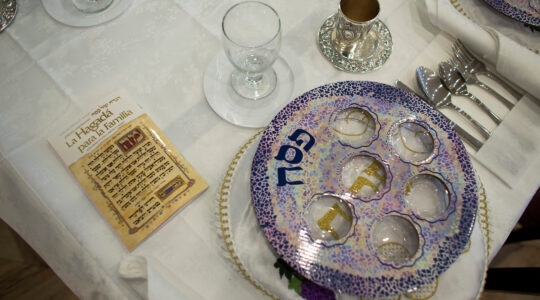
Where to find a Passover seder in New York City in 2024

From Alvin Ailey to Elie Wiesel, 14 standout moments from 150 years of the 92nd Street Y

Wandering Jew Plant – Ultimate Care Guide
By: Author Daniel
Posted on Last updated: September 18, 2023

Sharing is caring!
- Facebook 60
You are reading this guide to learn more about the Wandering Jew Plant and its care . I have had this plant at home for many years and write about all the growing aspects in this guide.
Wandering Jew Plant Care Takeaways
What is the wandering jew plant.
The Wandering Jew, or Tradescantia zebrina, by its scientific name (old name = Zebrina pendula) is native to Mexico. It is not to be confused with Tradescantia albiflora, which also goes by Wandering Jew and has very similar care needs.
Tradescantia zebrina has attractive foliage, sporting exciting zebra-patterned leaves. It also flowers. But when kept as a houseplant, this rarely ever happens. It is a fast-growing and excellent groundcover, according to the University of Florida .

W andering Jew Plant Care
To keep your Wandering Jew plant thriving, ensure it receives bright, indirect sunlight. Keep it in average room temperatures of 60-75°F (16-24°C). Fertilize once a month during spring and summer. In winter, relocate the plant to a cooler area with temperatures of 54-59°F (12-15°C).
Table of Contents
Tradescantia zebrina Growing guide
Tradescantia zebrina care is pretty straightforward, but it certainly can’t hurt to glance at the most important things to consider when caring about this herbaceous perennial plant.
So, without further ado, let’s see how you can make your Wandering Jew, aka the Inch plant, as happy as possible.
Any good potting soil will do for your Wandering Jew. For instance, this could be Miracle Gro potting soil readily available online in stores like Amazon.
But these plants not only feel very comfortable in soil but can also be kept in hydroponics .
Sunlight is a vital aspect when it comes to the well-being of most houseplants. Some houseplants do well with moderate sunlight, while others only thrive (or flower) when a certain level of sunlight is guaranteed.
The Wandering Jew does best in bright, indirect sunlight .
If you are unsure what that means, please look at our Light Levels article.
The Wandering Jew, a tropical native, thrives best when the root ball is always well moisturized. Still, waterlogging should be avoided whenever possible, as this could lead to root rot .

This tropical plant does not enjoy limy water. Use soft water whenever possible. Rainwater and distilled water are very good choices.
Temperature
People who own an Inch plant and keep it outside run the risk of exposing it to cold temperatures. This is where indoor plant owners have the upper hand.
Wandering Jews can thrive with average room temperatures of 60 to 75°F (16 to 24°C) if it doesn’t drop for long periods. Anything below 12°C for an extended period could be fatal for your Wandering Jew.
Wandering Jews prefer a humidity of around 70%
The perennial, herbaceous Wandering Jew plant is native to Mexico, Central America, and Colombia, so it should not surprise you that it likes a good deal of humidity.
To ensure high humidity levels, regularly misting your plant is a very good idea. A hand mister filled with water does the trick.
As for the location, you may want to keep your Wandering Jew in the bathroom , as this is usually the place in the house with the highest humidity.
Feed your plant once a month during spring and summer. In winter, fertilizing is not necessary.
Also, fertilization of the Wandering Jew is only necessary from the second year of cultivation or after repotting.
Propagation
It is best propagated through stem tip cuttings. Propagating the Wandering Jew is an easy task.
Wandering Jews don’t get very tall. They might reach a height of about 14 inches (36 cm) when kept indoors. They spread to about 10 inches (25 cm).
(Re)potting
The thing with the Wandering Jew is that it grows fast , hence its nickname “Inch plant.” Because of its fast-growing pace, the plant usually gets very leggy, and leaves are often lost near the base of the plant.
Repotting is pivotal for keeping the root system healthy regardless of the actual plant species. However, how often a houseplant needs to be repotted depends on various factors.
Some houseplants grow incredibly fast, so they need to be repotted often. Others, on the other hand, grow very slowly, so repotting is not a top priority.
That said, repotting your Wandering Jew occasionally is a good idea.
How long does a Wandering Jew live?
As far as the longevity of Wandering Jews goes, they often don’t get older than 2 to 3 years.

Wandering Jew Watering
Water about once every 5-7 days in spring and summer. Keep the soil slightly humid. Do not let the Wandering Jew dry out between waterings. Use your index finger to check if the soil is dry down 1-2 inches of soil (2.5 – 5 cm).
Reduce watering to every 10-14 days in autumn and winter.
Wandering Jew Propagation
The Wandering Jew roots very easily . The plant can easily be propagated through stem tip cuttings.
When propagating your Wandering Jew, make sure that your plant is in a healthy condition.
Please follow our step-to-step guide to propagate your Wandering Jew through stem tip cuttings.
Propagation through stem tip cuttings
- Identify the plant that you want to replicate. It should have healthy growth and plenty of stems.
- Make clean cuts on sections that are three to six inches in length .
- Use a sharp knife and carefully cut the leaves on the stem’s bottom half.
- If you want, you can dip the exposed end of the stem in a rooting hormone . This will speed up the rooting process. However , it is unnecessary .
- Place your stem tip cuttings into a pot with fresh soil after thoroughly watering the potting mixture.
- Use a clear plastic bag to hold in moisture, taking it off to water weekly .
- Keep your eyes on the plant for new growth . You should start to see roots in about two to three weeks . Once this happens, transfer the plant babies to a larger pot.
Note: Instead of rooting your stem tip cuttings directly in soil, you could also root them in water .
Wandering Jew Pest Control
Wandering Jews are prone to aphids and spider mites attacks. So, you will need to look out for these two little pests.
Some of these are known to cause defoliation, while others can kill the plant altogether. Depending on the severity of the infestation, you may need to use chemicals or insecticides .
Aphids on my Inch Plant
The Wandering Jew is not particularly susceptible to plant diseases or pests. Yet, you might have to deal with an aphid attack at some point. These parasites pierce the leaves of their host plant and suck their sap.
Like scale insects, they excrete sticky honeydew, by which you can immediately recognize the infestation.
Aphids can multiply explosively, especially in warm , dry environments.
As a preventive measure, ensure regular watering and occasional misting of your Wandering Jew.
The best way to combat aphids is to control them mechanically by rinsing them off the plant with water . Isolate the plant from the rest of the collection.
Pest Prevention
To prevent the Wandering Jew from pest infestations, plucking dried leaves regularly makes sense as well as using neem oil. The dried leaves lying on the substrate must be removed. Otherwise, there is a risk of rotting or infestation by parasites and fungi .
Wandering Jew Problems
Brown leaf tips.
Brown leaf tips is a very common problem with a wide variety of houseplant. Depending on the species, the causes for this problem can be very different, though.
So what causes leaves to turn brown with Wandering Jews?
My Wandering Jew has only green leaves (not enough variegation)
If you do own a variegated Wandering Jew but only see a great amount of non-variegated leaves, chances are that your plant does not get enough sunlight .
To solve the problem, allow your Wandering Jew some bright, indirect sunlight by placing it in a sunnier location.
Fading leaves
If your inch plant’s foliage is suddenly losing color and sports fading leaves, this is another sign that it does not get enough sunlight .
Dropping leaves
Dropping leaves is another very common problem many plant parents must deal with regularly . If your Wandering Jew drops leaves, this is usually due to too low or too high temperatures .
In summer , ensure your Wandering Jew is exposed to average room temperatures.
In winter , it should be kept in a cooler environment.
Is Wandering Jew care difficult?
Wandering Jews are considered low-maintenance plants and are perfectly suitable for beginners.
They do well at average room temperatures, don’t demand a very high level of humidity (which is sometimes difficult to achieve in a home environment), and it is very easy to propagate them through stem tip cuttings.
Which plant species are commonly referred to as “Wandering Jew”?
Tradescantia zebrina as well as Tradescantia albiflora.
What is the difference between Tradescantia zebrina and Zebrina pendula?
There is no difference between Tradescantia zebrina and Zebrina pendula. Zebrina pendula is just the old name for Tradescantia zebrina.
Does my Wandering Jew flower at all?
Wandering Jews are indeed flowering plants. However, when kept indoors, they very rarely flower.
How long can you keep a Wandering Jew?
If you don’t propagate your Wandering Jew, you can keep it for about three years. After that period, the quality of your Wandering Jew will most likely decrease. If you regularly propagate your leafy friend through stem tip cuttings, you can keep it indefinitely.
Any display tips for Wandering Jews?
Wandering Jews look great in hanging planters!
Is the Wandering Jew toxic to cats?
The Wandering Jew plant is toxic to cats. Therefore, you have to keep your cat away from this plant.
Is the Wandering Jew toxic to dogs?
Yes, the Wandering Jew plant is toxic to dogs. Therefore, you must ensure your dog does not come in contact with this plant.
What are the health benefits of Tradescantia zebrina, if any?
Not only is The Wandering Jew a beautiful houseplant famous for its striking foliage, but it also presents several health benefits for humans. It is especially known for its antioxidant and antibacterial activity, and it is widely used in Traditional Medicine in several countries. Tradescantia zebrina is also believed to be a valuable source for treating kidney diseases.
The Last Zebrina
The Wandering Jew is a great houseplant that looks stunning in hanging planters. Its care is easy apart from its humidity-loving nature.

Daniel has been a plant enthusiast for over 20 years. He owns hundreds of houseplants and prepares for the chili growing seasons yearly with great anticipation. His favorite plants are plant species in the Araceae family, such as Monstera, Philodendron, and Anthurium. He also loves gardening and is growing hot peppers, tomatoes, and many more vegetables.
Related Posts
(image credits, IG:oohyouplantsy) I have a hide-away in my home that I escape to for…
How much light does my plant need? This is a relevant question as too little…
I love plants that offer an eye-catching burst of color. They sure put a smile…
Most of the 45+ species in the Monstera genus are famous for their unusual leaves…
One of the rarest Anthuriums is the Anthurium Reflexinervium, a gorgeous plant naturally found only…
Hoya Lauterbachii belongs to Hoyas's family, which are known to be the largest plants on…
How to Grow and Care for a Wandering Dude Plant
Here’s how to care for this pretty trailing plant.
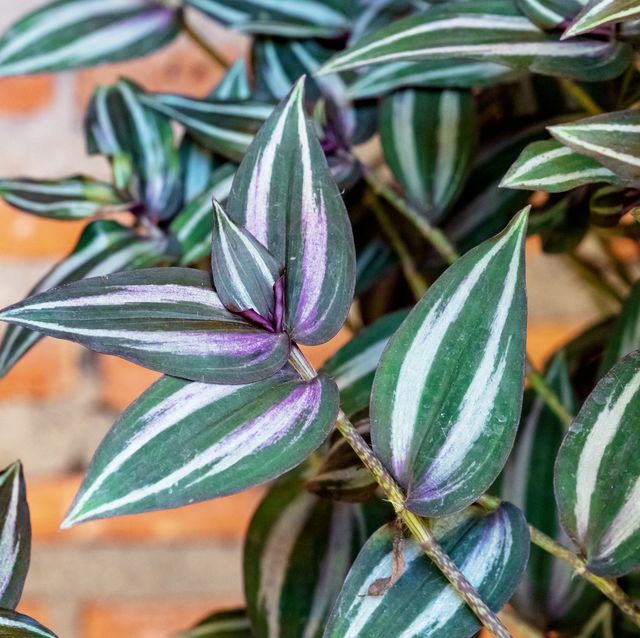
Country Living editors select each product featured. If you buy from a link, we may earn a commission. Why Trust Us?
With its long dangling stems, this plant tends to “wander” all over the place. Today, the plant often is called by its botanical name, Tradescantia, with “zebrina” referring to its silver striping.
It’s sometimes also called silver inch plant, but it can be confused with another plant, commonly called inch plant, Tradescantia fluminensis , which has solid green foliage.
Other varieties of wandering dude have become widely available in recent years, including the very popular nanouk type, which has foliage with pretty pinkish stripes and magenta undersides.
Native to Mexico, Belize, Guatemala and Honduras, the wandering dude usually is grown as a houseplant, but in USDA Hardiness zones 9 to 11 , it can be grown as a low-growing ground cover, too. ( Find your zone here .)
Read more: 15 Common Houseplants to Grow and Brighten Up Your Home
Ahead, learn everything you need to know about how to care for a wandering dude plant:
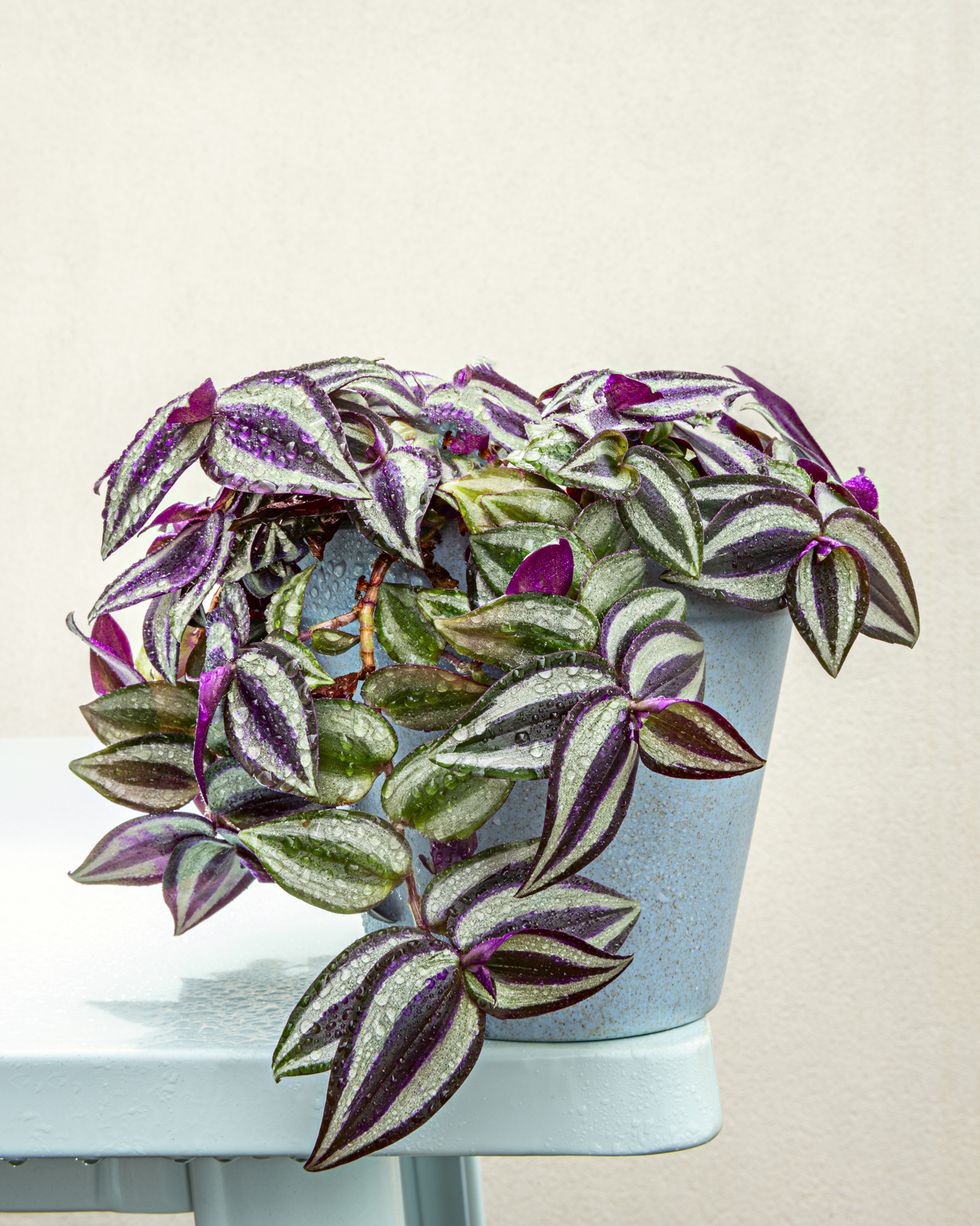
Wandering Dude Basic Info:
- Common Name: Wandering dude
- Botanical Name: Tradescantia zebrina
- Plant Family: Commelinaceae
- Type of Plant: Perennial, grown as houseplant
- Native Origin: Mexico, Belize, Guatemala, Honduras
- Sun Exposure: Full sun to part shade
- Mature Size: 6 inches tall by 1 foot wide
- Toxic to pets: Yes
Why Trust Us
I'm a garden writer with more than 15 years of experience growing houseplants, edibles, and landscape plantings. I also regularly trial new plant cultivars for performance and reliability, and test garden products to evaluate practicality and durability.
How Do You Care For a Wandering Dude Plant?
Give wandering dude bright, indirect light. If it doesn’t get sufficient light, this plant tends to get gangly and unattractive. Its purple coloring also may fade in low light, which means you should move it to a more brightly-lit room or use a grow light.
If your wandering dude is starting to get scraggly, simply snip off a few inches from the end of each stem to help stimulate the plant to push new, bushy growth. You can use plant snips or your fingers. You may need to pinch back frequently because wandering dude is a fast grower.
How Do You Water a Wandering Dude Plant?
You should water only when the plant feels mostly dry. Poke your finger in the soil before watering; if soil clings to your finger, wait a few more days and recheck.
If you let it get too soggy, that’s a sure way for it to get mushy and die. Like most houseplants, it’s better to err on the side of too dry, rather than too wet.
If you like, you can feed this plant with any general-purpose houseplant fertilizer, but it’s not entirely necessary.
Miracle-Gro Miracle-Gro Water Soluble All Purpose Plant Food, 3 lb
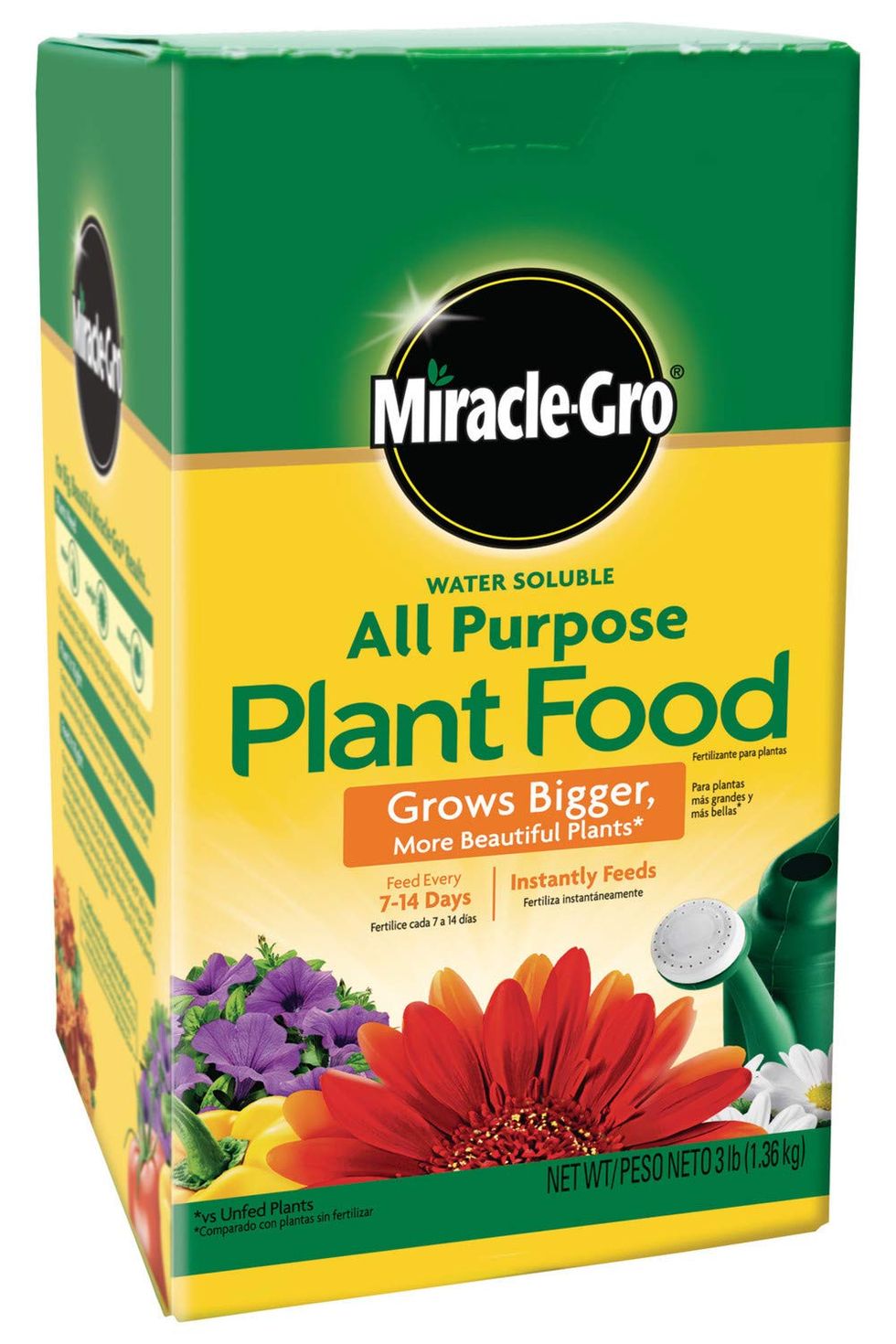
Can You Grow Wandering Dude Plant Outdoors?
Yes, it makes a great trailing plant spilling out of containers! Pair it with tall plants such as hibiscus, canna, elephant ears, or other tall, upright tropicals. If it starts to get leggy, just trim it back. Outdoors, it does best in full sun (northern climates) to part shade (southern climates). It may develop tiny pinkish flowers outdoors, though it rarely flowers indoors.
How Do You Propagate a Wandering Dude Plant?
Like pothos , this is a great plant to propagate to share with friends or to make new plants for yourself. Simply take a cutting, say, if it’s getting too long, then place it in a glass of water to root. Keep it in a bright spot in your home (not direct sunlight), and watch for roots to develop within about two weeks. Then plant in regular potting soil, and keep the soil lightly moist while it settles in.
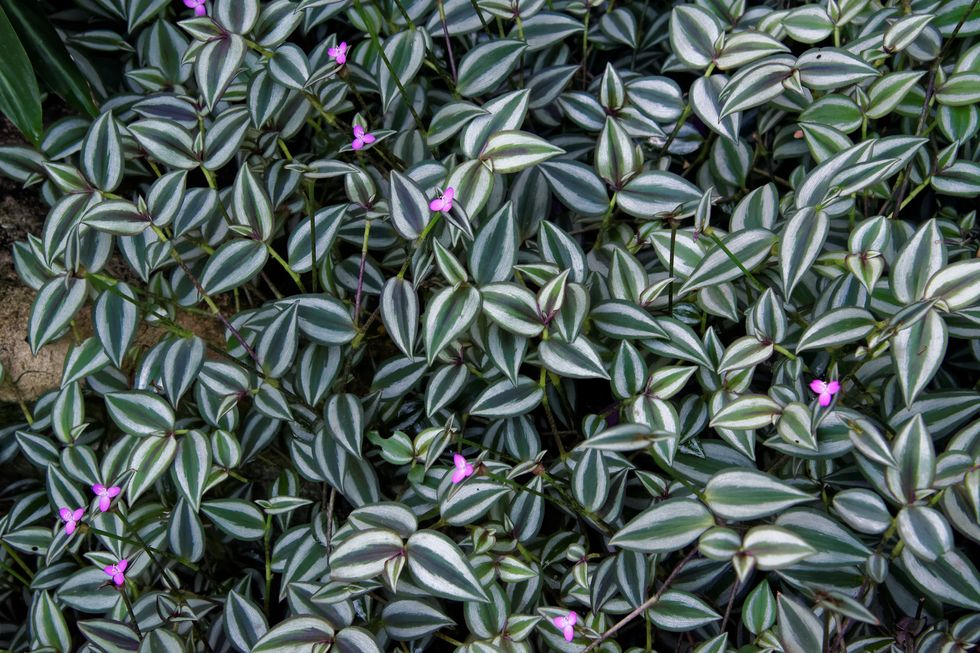
Is Wandering Dude Toxic to Pets?
According to the ASPCA , this plant is toxic to pets and may cause dermatitis, or irritation of the lips and mouth. But remember that any plant may cause vomiting or GI distress if eaten in large enough quantities, so keep this away from pets who are nibblers. Finally, call your vet ASAP if you suspect your pet has ingested it, even if you’re not sure. It’s always better to be safe than sorry!
In addition, the plant sap also may cause skin irritation in some people. Wear gloves when handling cuttings if you tend to have sensitive skin.
Read more: 28 Pet- Friendly Houseplants You Can Grow Without Worry
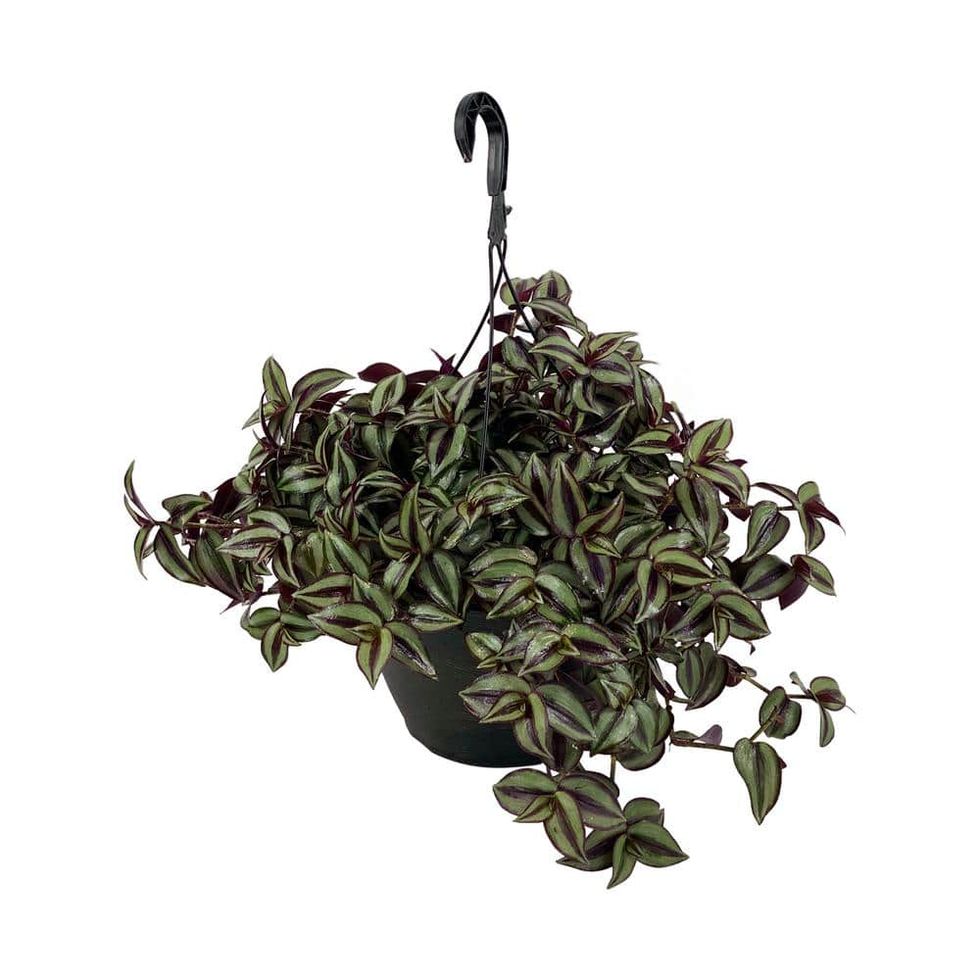
Vigoro Tradescantia in 11-inch Hanging Basket
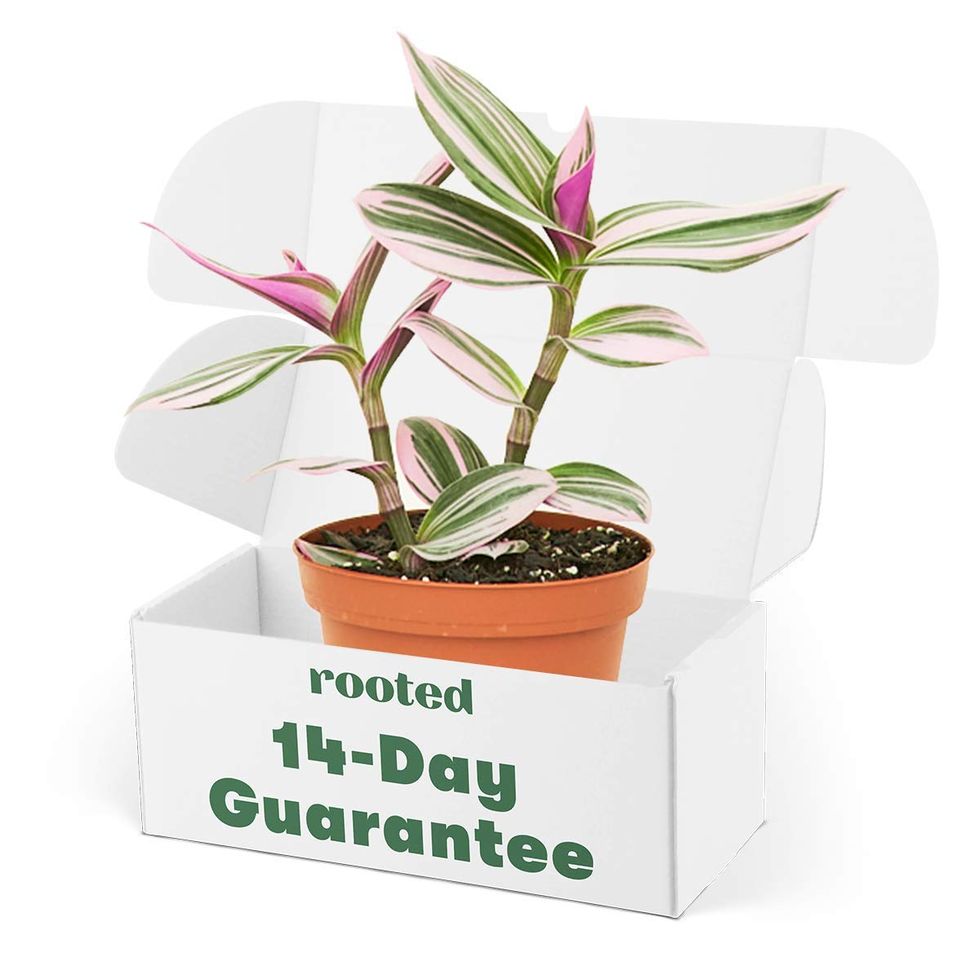
Rooted Tradescantia Nanouk, 4-inch pot
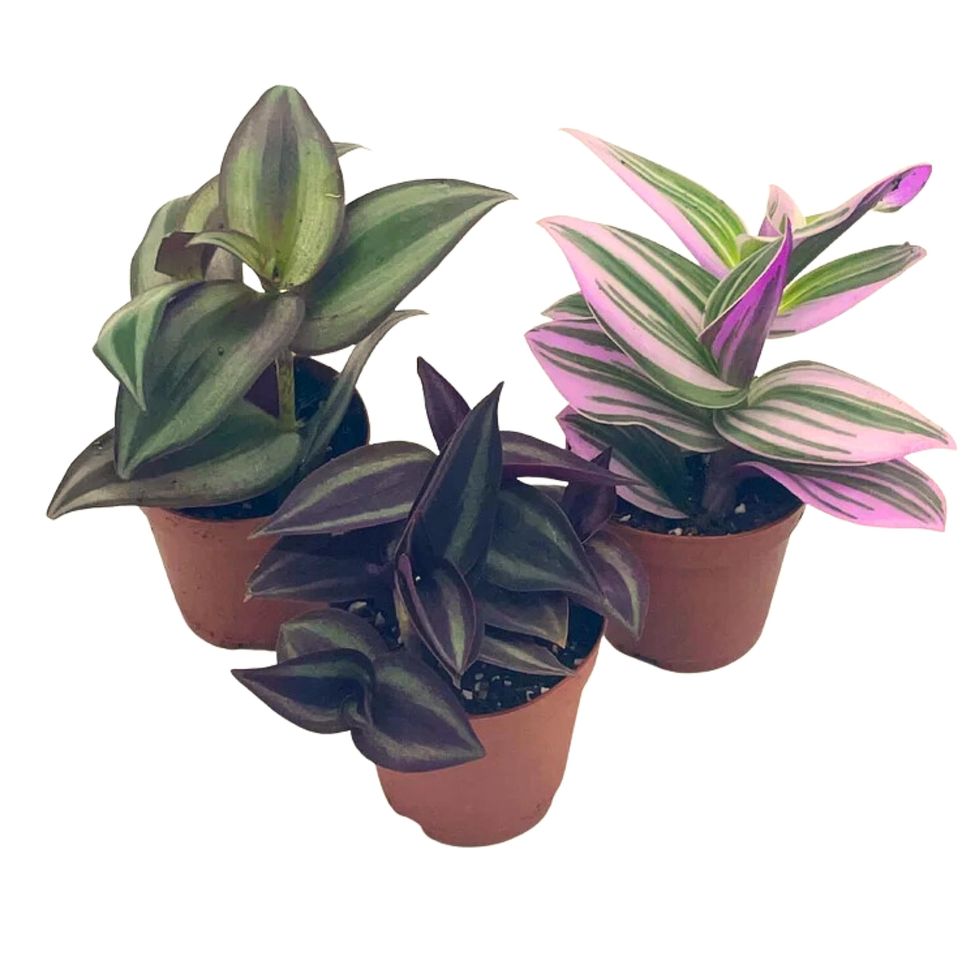
BubbleBlooms Wandering Dude Assortment
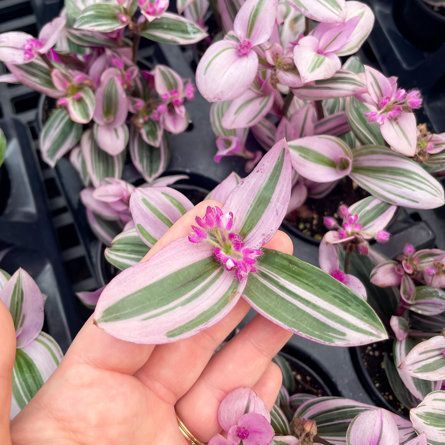
Wayfair Tradescantia Nanouk, 4-inch pot
Arricca Elin SanSone has written about health and lifestyle topics for Prevention, Country Living, Woman's Day, and more. She’s passionate about gardening, baking, reading, and spending time with the people and dogs she loves.
.css-1shyvki:before{background-repeat:no-repeat;-webkit-background-size:contain;background-size:contain;content:'';height:0.819rem;margin-bottom:0;margin-right:-0.9375rem;width:3.125rem;}.loaded .css-1shyvki:before{background-image:url('/_assets/design-tokens/countryliving/static/images/arrow.svg');}@media(max-width: 48rem){.css-1shyvki:before{display:none;}}@media(min-width: 40.625rem){.css-1shyvki:before{display:inline-block;}} Gardening Encyclopedia .css-unxkmx:before{background-repeat:no-repeat;-webkit-background-size:contain;background-size:contain;content:'';height:0.819rem;margin:0.7rem auto 0.9375rem;width:3.125rem;}.loaded .css-unxkmx:before{background-image:url('/_assets/design-tokens/countryliving/static/images/arrow.svg');}@media(max-width: 48rem){.css-unxkmx:before{display:block;}}@media(min-width: 40.625rem){.css-unxkmx:before{display:none;}}

12 Big Leaf Houseplants You Need ASAP
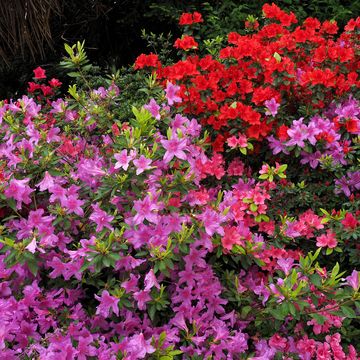
How to Grow Beautiful Azaleas

18 Spring Vegetables That Are Best Right Now

86 Essential Garden Flowers (With Pictures)
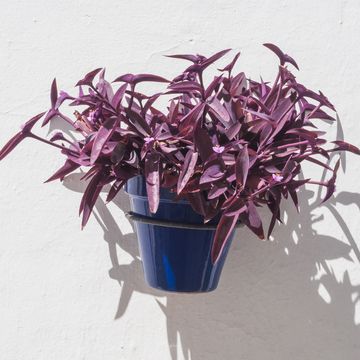
Here's How to Keep Purple Heart Plant Colorful
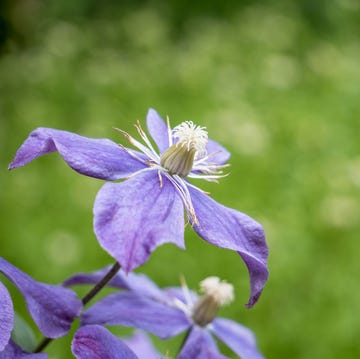
Your Guide to How to Plant and Grow Clematis

21 Indoor Plants to Breathe Life Into Your Home

Get Started on Your Spring Garden Plan Now
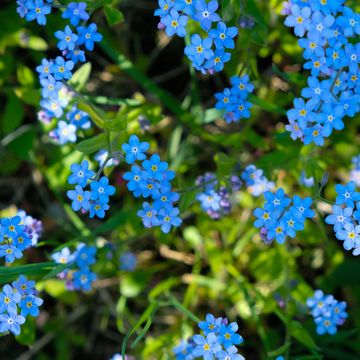
Here's How to Grow Forget-Me-Not Flowers
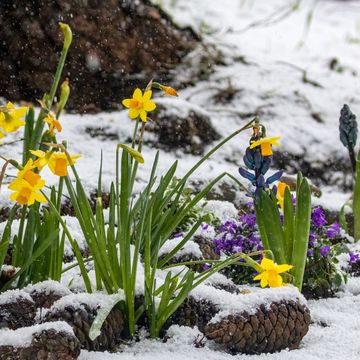
20 Winter Flowers That Add Life to a Snowy Garden
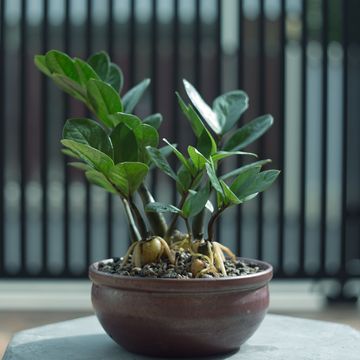
How to Care for a ZZ Plant

Order Your Almanac Today!
Caring for Wandering Dudes (Inch Plants)

Sign up for our daily newsletter to get gardening tips and advice.
Growing Wandering Dude Plants (Tradescantia Zebrina): Watering, Propagating, Lighting, and More
Tradescantia zebrina (wandering dude) is a type of spiderwort known for its attractive purple- and silver-striped foliage. This houseplant, also called in “inch plant,” knows how to survive any indoor environment and is perfect for the wanna-be-green thumb! Here’s how to care for an inch plant in your home.
About Tradescantia or Inch Plant
Tradescantia zebrina (pronounced trad-es- KAN -tee-uh zeb- REE -nuh) is a species of creeping plant in the Tradescantia genus. Common names include wandering jude and inch plant. This plant was formerly called Zebrina pendula and wandering Jew. Another common name is Variegated Spiderwort.
While Tradescantia zebrina is a perennial plant in its native Mexico, its treated as a houseplant in North America, and commonly grown in a hanging pot. It is considered invasive species in warm regions outside of their home ranges (including in parts of the southeastern U.S. ). For this reason, we recommend growing inch plants indoors or keeping them restricted to containers outdoors.
Not only does the inch plant have attractive leaves but it’s fast-growing, with trailing stems. Leaf nodes on the stem are supposed to be 1-inch apart, hence the common name inch plant. Each segment is capable of producing a new plant, so Tradescantia is e asily started from cuttings that root readily in moist soil.
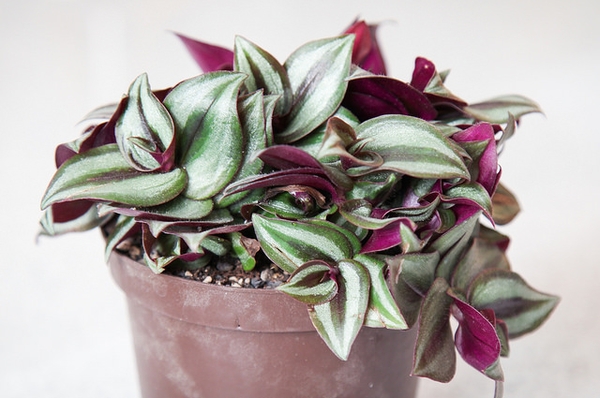
Shamrocks and Four-Leaf Clovers: What's the Difference?
Easy houseplants for your home, 20 easy-to-grow perennial flowers for beginners.
- Grow in all-purpose indoor potting mix in either a pot or hanging basket.
- Select a location with filtered sun. Keep inch plants out of direct sunlight and out of dark areas, which will cause them to become leggy.
- The room temperature should be average (between 55° and 75°F).
- Water deeply, but allow the soil to dry partially before watering again. This plant doesn’t like to dry out, but it also doesn’t like to be constantly wet.
- Water less during the winter months, which is the plant’s resting period.
- Provide fertilizer twice a month in the spring and summer; don’t fertilize in fall and winter.
- Pinch back to keep this trailing plant contained as well as promoting bushier foliage.
- Removed leggy growth also allows for cuttings that can be used for propagation.
- Plants can be pruned back hard every spring and can be taken outside on a protected patio in the summer.
- Tradescantia zebrina ‘Tricolor’ (pictured at the top of this page) has beautiful purple and green leaves with shiny silver stripes.
- Tradescantia pallida ‘Purple Heart’ has fuzzy, purple foliage.
- Tradescantia fluminensis ‘Quicksilver’ has variegated white-green foliage.
- Inch plants can easily be propagated by cuttings. Snip off a piece of the plant (the cutting should ideally be 3–4 inches long) and place the cut end in water. In about a week (or less), the cutting should produce roots. A week or so after that, plant the cutting in a pot according to the planting guidelines above.
- No serious insect or disease problems.
- Aphids tend to be a problem on the stems and leaves. Monitor for aphids (and other small insects), as they could become an issue if unchecked. To get rid of them, pinch off the infected stems and spray the plant with water.
- Root rot and stem rot can occur in soggy soil.
- Note that contact with plant sap causes skin irritations in some individuals.
Catherine Boeckmann

ADVERTISEMENT

50 Fall Flowers and Plants for Autumn!

Top Succulent Plants for the Home

How to Propagate Plants From Cuttings

I am not about to call a plant "dude". Stop being ridiculous, stop with the DIV garbage. Keep your roots.
I love the Wandering Jew hanging baskets. Last year they were priced at $40 a basket and I have 3 baskets and was not paying that much so when it came time for the first frost and the leaves started browning I clipped about 25 or so cuttings and put them in juice glasses on my dining table. I changed the water regularly but the whole winter they stayed in the juice glasses in a place with indirect sunlight. In early spring I transplanted them into the baskets with potting soil and some fertilizer. They were tiny little spindles and now they are thriving! I love them!
We love how quickly the inch plants grow and propagate! Thank you for sharing your story with us.
- Jenn, Associate Digital Editor
A good article on the care of the wandering Jew plant. Although, I would like to add, that the branches of this plant are extremely tender. And you can break them off, just buy a glance. So I would caution anyone, to handle them with care. Once it's established as a full-sized plant, it's a more little hardy. But, as a young cutting. Those stems are very tender.
Just because something has "always been this way" or you're old is not a good reason to continue. We constantly learn and evolve our language. The National Gardening Association (NGA) and a number of professional horticulturalists have acknowledges this. Unless you're a plant person or Jewish, I'm not sure you would know. I'm glad the Almanac's forward thinking and not anti-semitic; it may take a few years for regular people in plant stores to catch up. As someone else said here, "Just because you find something inoffensive doesn't make it so."
The genus Tradescantia commemorates John Tradescant the Elder (1570s-1638). Massively famous and significant. An extraordinary plant hunter and master gardener who began his career as head gardener to Robert Cecil, 1st Earl of Salisbury ... gardener to the royal favourite George Villiers, 1st Duke of Buckingham ... Keeper of his Majesty's King Charles I's Gardens, Vines, and Silkworms ... the Oxford Physic Garden. His royal patrons sent him all over to collect for their gardens and greenhouses -- the Low Countries, Arctic Russia, the Levant/North Africa. With his son, maintained their own garden and museum in South Lambeth, known as the Tradescants' Ark -- the first public museum in Britain. The common house plant under discussion here was sent to him by a friend in Virginia (it is indigenous to Mexico); another friend sent the scarlet runner bean from the West Indies. His son, John Tradescant the Younger, was also a traveller (mostly to North America), plant hunter, master gardener. Their huge museum collection went to Elias Ashmole and became the foundation of the Ashmolean Museum in Oxford. This link lists some of the 750 species they brought to England: https://people.elmbridgehundred.org.uk/biographies/john-tradescant/ They were just as famous for the numerous "rarities" in their large museum of the world, among which is one of the few specimens of the extinct dodo. Their travels explain the "Wandering" part of the houseplant's name. Were they Jewish? If they were Jewish in 17thC England, it would likely have been a private matter. Casual research turns up nothing certain, only this suggestion from a 1638 visit: "The Christian world is also indebted unto that painful industrious searcher and lover of all nature’s variety for the late knowledge of the spiderwort..." -- though that might only signify collection from nonChristian territories. (You can find the whole letter here: https://thejunket.org/2015/01/issue-thirteen/tradeskin/.) But I would like to think they were.
"some PC nonsense... forced on the public" and "a perfectly good name and there's nothing offensive about it"
The name refers alternatively to the legend that a Jew mocked Jesus on the way to the cross and was forced to wander the Earth until the apocalypse or to the supposed itinerant, rootless nature of Jews. There are centuries of stereotypes built around these myths. Please consider that the world is larger than what you know. Just because you find something inoffensive doesn't make it so.
Thank you for the information you provided about the name “Wondering Jew” I did not know this..was very interesting. I was just going to post on social media about my plants didn’t know the correct name I didn’t want to offend anyone reading this put my mind to ease. Again thank so much for your comment.
It has been called the wondering Jew as far back as I can remember how on earth did they come up with the inch plant really!!!
How did they come up with inch plant? It's literally in the article that "Leaf nodes on the stem are supposed to be 1-inch apart, hence the common name inch plant". Yet you think "Wandering Jew" is a great descriptor of a plant? Considering the term is based on anti-Semitism I'm surprised anyone would argue for continuing to use a term once ignorance of it's impact can't be an excuse. To knowingly say that your desire to say words outweighs someone else's desire to not be subjected to casual racism is unbelievably selfish. When offered the chance to be better, to do better, why on earth would you not take it?
- More Comments

Wandering Jew: Types, Care, and Propagation
Table of contents, wandering jew - an introduction.

Types of Inch Plants
- Tradescantia fluminensis: This variety has fleshy ovate leaves with white and green variegations attached to fleshy stems. It has triangular white flowers with three petals.
- Tradescantia zebrina: The variegated leaves resemble the stripes of a zebra, the purplish-green leaves have a silver edge. One of the hardiest and quickest growing wandering jew varieties.
- Tradescantia pallida: Also famous as the Purple heart plant for its deep purple foliage and light purplish-pink flower. It stands out amazingly both as ground cover and as hanging plants.
- Tradescantia blossfeldiana: The thick green leaves have a fuzzy texture with a white and green variegated upper side and a purple underside. The plant has clusters of beautiful blue, purple, white, and pink flowers.
- Tradescantia Sillamontana: This plant has beautiful symmetry with leaves growing on thick succulent-like stems covered in white fuzzy hair. It produces magenta flowers in season.
- Tradescantia spathacea: Also famous as ‘moses in a blanket’, ‘oyster plant’, or ‘boat lily’, it's almost succulent like in nature. It has dark green leaves with purple underside growing in spiral patterns
Wandering Jew (Tradescantia) plant care
The creeping-inch plants love bright indirect light but also do great with a few hours of direct light. Plant your wandering jew plant near a south-facing window where it can get at least 6 to 7 hours of bright indirect light. Growing your spiderwort in North-facing balconies and terraces is also a good idea. If the colour or variegations on the leaves start to diminish then it is a clear sign of low light. Shift your plant to an area with brighter light conditions.
The wandering jew plant likes its potting mix to be kept uniformly moist at all times but not soggy at all. Under indirect light conditions, water your wandering jew plant once per week or when the top soil dries out. Don't let the soil dry out completely. However, when watering your dried potting mix, water it in batches to ensure that the soil absorbs all the water and it just doesn’t run out of the planter. Water a little and then wait for a while for the soil to soak up the water before watering it again till it drains out of the drainage hole at the bottom of the planter.
The creeping inch plant is not very finicky about the soil it grows in. It thrives in a well-draining but rich potting mix. The key points to be kept in mind is allowing the topsoil to dry in between waterings and also aerate the soil once in a while. Since the spiderwort plant loves moist potting mix, it is very important that it is well-draining and well-aerated so root rot can be avoided.
Fertilisers
Use a well-balanced and generic houseplant fertiliser for your wandering jew plant. They are not heavy feeders and do well with both root and foliar application every 15 days. Use a good quality fertiliser like the Ugaoo Plant Tonic for this. Using NPK is also a good idea. Dilute the fertiliser as instructed and apply directly to roots once in 15 days and put it in a misting spray and do a foliar application too once in 15 days. The foliar application guarantees bigger and showier leaves. However, don't overfeed the plant as it causes the leaves to lose their variegations.
Propagating Wandering Jew Plant
Problems with the inch plant and how to deal with them, .
Share this:
- Share Opens in a new window.
- Tweet Opens in a new window.
- Pin it Opens in a new window.
- Email Opens in a new window.
- Whatsapp Translation missing: en.general.social.alt_text.share_on_whatsapp
- Betel Leaf Plant: Care, Benefits, and Propagation
- Dracaena : Care, Types, & Propagation
You may also like
Cleaning your pruning tools: why and how to, a gardener's best friends: what are the benefits of using watering cans, why should you prefer organic fertilizers for plants, how to get rid of mushrooms in houseplants.
- Choosing a selection results in a full page refresh.
- ${ item.displayLabel }$
Please try with different query 0" >or try clearing Filters. .
Please try again or visit our home page..

Reset your password
We will send you an email to reset your password
Welcome back! Sign in with
New here? Create an account
Create an account with
Or use your email
Already have an account? Sign in
Advertisement
More from the Review
Subscribe to our Newsletter
Best of The New York Review, plus books, events, and other items of interest
- The New York Review of Books: recent articles and content from nybooks.com
- The Reader's Catalog and NYR Shop: gifts for readers and NYR merchandise offers
- New York Review Books: news and offers about the books we publish
- I consent to having NYR add my email to their mailing list.
- Hidden Form Source
May 9, 2024
Current Issue

What’s in a Face?
May 9, 2024 issue

Robert Stothard
Clockwise from top left: Rio, Fiona, Dena, Sanjoy, Kenneth, and Yidel; photographs by Robert Stothard from What Does a Jew Look Like?
Submit a letter:
Email us [email protected]
What Does a Jew Look Like?
צלם משוטט [Wandering Photographer]
Recently, when friends have asked what I am working on and I’ve told them that I am reviewing a British photo-essay book called What Does a Jew Look Like? , they have reacted with a nervous giggle. This has sometimes been followed by “Wow!,” “Oy,” or an ominous “Uh-oh.” The uneasiness stems, I think, from the question itself, not its possible answers. What a Jew looks like has been a subject, indeed obsession, of Jews and non-Jews, of antisemites and Zionists, of novelists and artists, of Europeans and Arabs. The question is sometimes posed as a matter of aesthetics, but it is always fundamentally political.
Keith Kahn-Harris and the photographer Robert Stothard, the British authors of What Does a Jew Look Like? , believe that the titular question is germane. Jews are a minuscule minority in Britain: they number fewer than 300,000 out of a total population of over 67 million. Too often, Kahn-Harris argues in his introduction, British newspapers illustrate articles on Jewish subjects with a stock picture of two “black-hatted, black-coated” Haredi Jews walking down a street, backs to the camera. No faces are shown:
They are mysterious, perhaps secretive, and women are invisible. Such Jews are made generic because they seem to be the “most” Jewish…. Only those who cannot be assimilated into “us” can truly represent “them.”
The Jewish community in Britain, though small, is hardly invisible. Jews are prominent in academia, journalism, medicine, and other professions. Indeed, Kahn-Harris notes, “Jews in this country have never been more visible, more spoken about and also more outspoken about themselves.” But as has been true so often throughout Jewish history, such visibility isn’t entirely welcome and can create, among the larger population, confusion, discomfort, suspicion, and resentment. In fact, charges of antisemitism rocked the Labour Party during the tumultuous five years, beginning in 2015, when Jeremy Corbyn was its leader. Since the Hamas attacks of October 7, the subsequent Israeli invasion of Gaza, and the furious worldwide protests the latter has prompted, Jewish visibility—and antisemitic tropes and attacks—have vastly increased.
“Are Jews a religion, an ethnicity, a nation or something else?,” Kahn-Harris asks. “Are Jews ‘white’? Are Jews Zionists? Are Jews rich? And what do we do with Jews who…do not fit into any existing category?” After several thousand years, Jews remain, it seems, a puzzlement.
To counteract stereotypes, What Does a Jew Look Like? presents a series of stately color portraits accompanied by brief testimonies from each subject. The book aims to complicate ideas about Jews and Jewishness, which will do nothing to counter antisemitism but is not in itself a bad thing.
And so we meet Dena from South London, a biracial woman who looks to be in her late teens. (The book provides no ages or last names.) Her frizzy black hair is held back by a headband; she tilts her head as she looks at the camera, perhaps suggesting a somewhat quizzical attitude toward the book’s project. Her green shirt, she tells us, denotes her membership in the youth group Noar Tzioni Reformi, or Young Reform Zionists. The daughter of a Ukrainian-Russian Jewish mother and a Nigerian Christian father, Dena describes herself as a “Liberal Jew…striving for equality.” She attends shul each Saturday. “I could see how it might be surprising for some people that I’m Jewish,” she says. “In the media Jews always look one way, with the big noses and stuff.”
The ultra-Orthodox are the fastest growing group among British Jews. Yidel, from Stamford Hill in London, looks to be in his mid-thirties; he sports a yarmulke, a trim beard, and payot . His calm yet slightly wary expression lends this picture its air of placid certainty. Yidel tells us that he is a member of the Bobov Hasidim: “Compared to some of the [other Hasidic groups], it’s quite neutral and non-specific in terms of its impact on everyday life.” He is a modern man, owner of an advertising business, but he’s a traditional man, too: “I want to raise my children the way I was raised.” He speaks Yiddish and English at home.
In contrast to Yidel’s tranquility, Rio, from Leeds, stares at the camera pugnaciously, as befits a man who has placed himself before a poster of the rock band Damn Vandals. He looks like a tough guy, with a scruffy beard, a partly shaved head, an earring, and tattoos (neck and arm). Rio was a teenage rebel, “oblivious to Judaism” until, as a young adolescent, his mother took him on a trip to Auschwitz. Then he began to study the Shoah in school and to listen to the stories told by his grandfather, who had been shipped to Siberia rather than to a death camp: “Hardly a consolation prize but ultimately the difference between survival and not (his parents weren’t so lucky though).” Rio avers that he is “totally irreligious.” But he recently lit a menorah at home: “After all, a lack of faith made no difference to the Gestapo or the KGB .”
The series continues: Rachel, a Holocaust survivor from what was then Czechoslovakia; Yael, whose Iraqi father immigrated to Israel as a child; Elliot, a gay man whose parents fled Iran’s Islamic Revolution. He regrets that, as a child of the diaspora, “I’m not as educated and experienced in the 2,700-year-old Iranian Jewish culture as I want to be.”
The childlike phrase “people who look like me,” which can be invoked with regard to anything from political representation and hiring practices to museum curation and journalism, seems omnipresent these days. In The New York Times the philosopher Kwame Anthony Appiah described the phrase, and the phenomenon it represents, as a “fervor.” This presumably left-wing version of tribalism bears an odd but unmistakable resemblance to that of right-wing populist movements; both rest, as the philosopher Susan Neiman argues in her recent book Left Is Not Woke , on the premise that “you will only truly connect with those who belong to your clan.” 1
The “looks like me” paradigm implies that appearance can accurately reflect, or even predict, experience, values, personal qualities, and ideas. Yet the most oppressive, indeed racist, systems—slavery, colonialism, Jim Crow, South African apartheid—rested precisely on the premise that those who share a physical appearance (more or less), or share membership in an ethnic or racial group, are essentially the same and constitute an undifferentiated mass. The denial of individuality is foundational to such regimes and to their maintenance of power. (The Taliban’s imposition of the burka, which obscures a woman’s face, is a contemporary example of this strategy.)
The insistence on individual recognition was central to the cry “Say Her Name!,” which rang out after Breonna Taylor’s killing in 2020; protesters demanded that the singularity, which is to say the dignity, of her unique life be recognized. Similarly, the Tunisian-French Jewish writer Albert Memmi noted in The Colonizer and the Colonized (1957) that the negation of particularity was a crucial aspect of colonialism: “The colonized is never characterized in an individual manner; he is entitled only to drown in an anonymous collectivity.”
It is the complication of identity—the antithesis of anonymity—that is the real contribution of What Does a Jew Look Like? It’s not just that these Jews don’t look the same, which is, in the end, trivial; it’s that, even if they did, they aren’t the same. This is especially true when it comes to intra-Jewish political conflicts, which are famously disputatious.
Events in England—and in Israel-Palestine—are interpreted by these subjects in starkly different ways. Fiona, from Brighton, avers that her Zionism informs rather than contradicts her support for Palestinian rights. Richard, a founder of the left-wing Pluto Press, belongs to a small anti-Zionist group within Labour. The second intifada, notorious for Palestinian suicide bombings and ferocious Israeli air strikes on the West Bank and Gaza, reinforced both his Jewish identity and his anti-Zionism. Paul, a realtor, was radicalized by the Gaza conflict in 2008, though in the opposite way; he sees his work with the Zionist Federation “as a continuation of being a soldier.” Adrian , a former student radical who wears a prayer shawl, opposes the death penalty and boycotts of Israel; Aron, who sits in front of a Patrice Lumumba poster, organized a “Kaddish for Gaza” in 2018. I am certain that, were we to interview these subjects today, we would find both a heightened sense of unity and more acrimonious divisions. That has been the paradoxical effect that Hamas’s terrorist carnage, the staggering death toll from Israel’s assault on Gaza, rising antisemitism, and the messianic-racist Netanyahu government have had on Jewish communities, families, and friendships.
What a Jew—or, rather, an Israeli Jew—looks like has become, oddly, a focus of attention, especially among some parts of the American left. In this view, Israelis are “white” and Palestinians “people of color,” and the Israeli–Palestinian conflict replicates the template of racial justice movements in the United States. The American tendency to reduce political questions to ones of race and skin color—which is both understandable and facile—has been transposed to a national-religious struggle in the Middle East. The US Campaign for Palestinian Rights and Jewish Voice for Peace describe Zionism as a form of “white supremacy.” The editorial board of The Harvard Crimson enthusiastically endorsed a “colorful” campus “Wall of Resistance” that defines Zionism as white supremacy as well as racism, settler colonialism, and apartheid. Israel is, however, one of the world’s most multiethnic countries; an estimated half of Jewish Israelis are descended or emigrated directly from the Arab countries from which they fled or were expelled. Far more Jews have immigrated to Israel from Morocco, Iran, and Iraq than from Germany, Hungary, and France. (The journalist Matti Friedman has dubbed Israel “Mizrahi Nation.”) Palestinians, too, are diverse and exhibit a range of skin colors and physical characteristics.
In some ways the attempt to transform the Israeli–Palestinian conflict into a white-and-black issue is comprehensible. Once one form of moral harm—racism, colonialism, patriarchy, antisemitism—is taken to be exemplary, there is a great temptation to transform it into the paradigm of all harm. But rather than strengthening arguments or movements, this kind of reductionism inevitably distorts them. To view any one form of oppression as the ur-evil that necessarily underlies all others is a form of parochial projection. Rather than enlarging one’s worldview, it results in a radical simplification.
A glaring example of this tendency was a 2021 article by the Israeli academic Nimrod Ben Zeev in the well-respected journal Middle East Report , which sought to explain the Israeli–Palestinian conflict in primarily racial terms. Ben Zeev offered valuable insights into the inequalities that existed among Ashkenazi Jews, Mizrahi Jews, and Arabs in the British Mandate period. He astutely observed, “As racial thought invariably does, it collapsed the variety within the groups supposedly represented into monolithic, discrete fictions.” But he argued that “race and imperialism” have “always…defined” the Zionist project, and he framed his arguments within W.E.B. Du Bois’s well-known observation: “The problem of the twentieth century is the problem of the color-line.” This was an astoundingly prescient argument when Du Bois formulated it in 1903; it presaged the anticolonial movements of the twentieth century that would transform the map, and the political realities, of the world.
But according to Ben Zeev, the twenty-first century presents few new challenges: the color line, in Israel as elsewhere, “remains a defining feature of the present.” Yet it is striking how few of today’s conflicts are centered on race. Putin doesn’t hate the Ukrainians because of their race or skin color. Conflicts in Africa that have killed millions—think of South Sudan, Somalia, Congo—are not predicated on either race or color. Nor are the crises that roil the Middle East. The competition between Iran and Saudi Arabia (yes, still), the persecution of the Kurds and Yazidis, the civil wars in Yemen and Syria, the often deadly strife between Sunnis and Shias, the determination of Iran to eliminate Israel, the current war between Israel and Hamas: all are national, political, ethnic, or religious—and sometimes involve a lethal combination of those factors. In most of these conflicts, the antagonists look like brothers. There is overwhelming evidence that it is quite easy to hate people who look like you.
David Serry, a prolific though amateur photographer, was born in Jerusalem in 1913; his parents and their families were among the first wave of Yemeni Jews who emigrated to Palestine in 1882. His images exude what I would call the syntax of optimism—the Zionist negation of the despair that has characterized so much of Jewish history.
Serry concentrated, though not exclusively, on the Yemeni community in Mandatory Palestine and, then, Israel. His photographs reveal a generational divide. Many of his older subjects look as if they stepped directly out of the Ottoman era. In a 1932 portrait a woman named Romiyah Nadav smiles at us as she sits on a divan covered in a richly patterned kilim; a striped rug, patterned pillows, and another kilim adorn her room. Her head and neck are swathed in a white headscarf; her long, elaborately patterned dress drops to her ankles; her black shoes are scuffed. In a 1950 photograph an elderly bearded man, wearing what looks like a turban, rides a donkey down a Jerusalem street; he’s a milkman, carrying a large metal jug and a long stick.
Ah, but the younger generation is different. The young women have dispensed with headscarves; their dark hair is fashionably bobbed; their formfitting dresses up to date; even their knees sometimes show! More than that: they look happy. One lounges, resting on her elbows, in a halter bathing suit and high heels on the Tel Aviv beach in 1940; she turns her head to the camera to smile slyly at us. Young men are car mechanics, construction workers, farmers. Time and again, Serry concentrates on sports and physical prowess: here is the muscular, healthy “new Jew” that Zionism aimed to create in refutation of the supposedly feeble Jew of the diaspora.
So what does a Jew look like in David Serry’s photographs? Many look like poor people of tradition who had lived in the Arab world for thousands of years; they are deeply rooted in the ancient rituals of their past and their people. The poverty etched onto their weary, creased faces suggest the hard lives they have lived. (They don’t look, to me, much like white supremacists or settler colonialists.) There is a solemn dignity to these portraits; Serry is offering a familial respect. Yemeni immigrants, viewed as culturally backward by other Israelis and by the state, would subsequently face harsh discrimination in jobs, housing, and education. But Serry captures young Yemeni Jews in a moment of unprecedented liberation—from centuries of political powerlessness, from persecution, and from the shackles (both religious and cultural) of the past that their elders treasured and still embraced.
What a Jew looks like became the leitmotif of the Documenta art exhibition in Kassel, Germany, two years ago and led to its implosion. As the New York Times art critic Jason Farago reported, “It began with a calumny; it ends with a crackup.” The exhibition, one of the art world’s largest, wealthiest, and most influential, was curated by the Indonesian group Ruangrupa, which invited contributions from other collectives, many based in what is now called the Global South. Several exhibitions from a variety of countries displayed antisemitic tropes; in these, what Dena from South London called “the big noses and stuff” played a starring role, as did Nazi references.
When the fair opened in June, its first crisis involved the Indonesian collective Taring Padi, which displayed an impossible-to-miss, nearly sixty-foot-long agitprop mural called “People’s Justice.” Its subject is the murderous Suharto dictatorship, the resistance to it, and the many foreign governments that aided the regime. (In this, Israel had a very small part.) It shows two Jews. The first is a pig-faced soldier with “ MOSSAD ” printed on his helmet, a red neckerchief with a Jewish star, and a belted uniform that recalls those of Nazi soldiers; behind him is an Orthodox Jew with payot , fangs, bloodshot eyes, and a hooked nose. He munches a cigar—in George Grosz’s work, a symbol of the venal Weimar plutocrat—and wears a black derby hat marked “ SS .” Other images in various exhibitions included Israeli soldiers depicted with bulbous noses with monkey-like faces, or as masked robots. Also shown were The Tokyo Reels , Palestinian propaganda and training films from the 1960s to 1980s that illustrated the “anti-imperialist solidarity” between Japan and the Palestinian movement. They were collected by Masao Adachi, a former leader of the Japanese Red Army, whose terrorist acts included the machine-gun massacre at Israel’s Lod airport in 1972. A festival committee of cultural experts urged that the films be canceled because they glorified terrorism and equated Israel with Nazi Germany. However, the screenings continued.
I tend to be extremely sympathetic to free speech arguments; artists have a right to create, and to show, repellent—even racist or threatening—images. (As a practical matter, though, Germany has no First Amendment, and antisemitic images that are considered “incitements of hatred” are illegal there. 2 ) What interests me, though, is the puzzling plethora of Jewish—or, one might say, anti-Jewish—images at the fair, and the startling lack of any countervailing ones. Just when the furor over one image had almost subsided, another popped up, like a crazily energetic jack-in-the-box that couldn’t be suppressed. A specter was haunting Documenta: the image of the Jew.
The representation of Jews in “People’s Justice” provoked an outcry among the press and some viewers; the mural was quickly removed. Far from objecting, Ruangrupa and Taring Padi apologized for the caricatures in written and oral statements, including to the Bundestag. “We collectively failed to spot the figure in the work, which is a character that evokes classical stereotypes of antisemitism,” Ruangrupa wrote, speaking for both groups. “We…are shocked that this figure made it into the work in question.” A sense of bewilderment pervaded these explanations; one member of Taring Padi asked, “How did this happen? How didn’t we see this?” Both groups denied that they are antisemitic.
Some have considered the innocent, surprised dismay of these statements to be disingenuous. But I believe the Indonesian artists, and I am grateful that they exposed the heart of the matter. Indonesia has a population of more than 270 million, of whom over 85 percent are Muslim; its Jewish community numbers approximately one hundred. It does not recognize the State of Israel. It is quite likely that most, and perhaps all, the members of Ruangrupa and Taring Padi had never met a Jew. Somehow, though, the image of the Jew as a symbol of prime malevolence had permeated their collective unconscious.
This is puzzling but not inexplicable. As the historian David Nirenberg showed in his disturbing, brilliant book Anti-Judaism (2013), a society doesn’t need any actual Jews in order to imagine—and be obsessed with—who they are, how they look, and what they represent. 3 For thousands of years, Nirenberg argues, Jews and Judaism have been used to explain a baffling array of contradictory phenomena including tyranny and revolution, carnality and intellectualism, capitalism and communism, insularity and cosmopolitanism, backwardness and progress. Jews in general and Israel in particular are a main prism through which otherwise disparate people conceptualize the world’s injustices. This is what the Yellow Vest nativist in France, the far-right nationalist in Poland and Hungary, the white supremacist in Charlottesville, and a section of the global left have in common. As Nirenberg noted, the conviction of the ancient Egyptians that Jews are enemies of all peoples and gods would remain “remarkably stable” over millennia.
At Documenta, the portrayals of Jews and Israelis nodded to modern politics and history, and especially to the indisputable wound of the Israeli–Palestinian conflict. But the images’ iconography, and certainly their ethos—the ubiquitous Jew as greedy, heartless, repellent, feral—can be found in centuries of Christian paintings, drawings, and engravings (and secular ones, too). The association of Jews with iniquity was not created by the Israeli–Palestinian conflict, which is especially, catastrophically, blood-drenched at the present moment. On the contrary, depictions of that conflict have easily incorporated, and unthinkingly reproduced, preexisting tropes. (Accusations that Israelis harvest organs from dead Palestinians—a modern version of the old blood libel—now circulate.) And the Documenta artists’ repeated references to Nazism were not a reflection on, or engagement with, the agonies of the Shoah but rather a lazy and ignorant exploitation of it.
Many political writers and activists have noted that oppressed peoples often absorb the hateful vision of themselves, and especially of their physical appearance, created by those who wield power over them. Toni Morrison’s novel The Bluest Eye (1970) exposes the power of racism through the story of a young, unloved black girl whose desire to be white, to look white, is a major factor that drives her to insanity. In an essay on the killing of Tyre Nichols by five black Memphis policemen last year, the journalist Jelani Cobb reminded readers that the cry “Black is beautiful” was directed not at whites but at black people “who had never considered the possibility that those two adjectives could coexist.”
Albert Memmi—who was simultaneously an anticolonialist, a socialist, and a Zionist—repeatedly analyzed the ways that colonized peoples, including Jews, internalize contempt; a chapter of his 1966 book The Liberation of the Jew is entitled “Self-hatred.” Memmi was born in 1920 and grew up in extreme poverty just outside the Jewish ghetto of Tunis. He pointed out that when it comes to physical appearance, a consistent “Jewish type” was a myth. In Portrait of a Jew , his classic study from 1962, he writes, “A separate Jewish race is an absurd concept.” A Polish Jew and an Iraqi Jew don’t necessarily look anything alike.
But a fantasy of shared characteristics—“the classic and unitary description”—indisputably existed: in this view, the Jew was short and swarthy, with dark curly hair, full lips, a large nose, and prominent ears. And although Jews share no single biological origin, Memmi described a colonized physique that was common among the ghetto’s inhabitants: “It is not surprising that oppression should leave its mark on the body.” Poor Jews shared with their poor Muslim neighbors “physiological misery, undernourishment and disease…. We were the same sickly, undersized individuals—either dark and shriveled like insects…or else unhealthily corpulent and yellow, billowing with obesity.”
It can be a Herculean task for the powerless to excise the Other’s picture of them. Memmi wrote of the “complexity of the Jew’s connection (like all oppressed persons) with the image non-Jews suggest of him. One thing is certain, he does not confine himself solely to denying it.” And here again—as it did at Documenta—the so-called Jewish nose makes a major appearance. “When a Jew has a big nose, it is as if he wore a permanent mark of his being a Jew in the middle of his face,” Memmi lamented.
That is to say, not the nose of the Jew he is, but the nose of the Jew people expect him to be. That poor nose…is here swollen with all the supposed Jewishness of its possessor. At once, as is the case with the Negro’s color, the Jew’s nose becomes the symbol of his misfortune and his exclusion.
For Memmi, Jewish shame was a psychological and existential problem, but one that only political self-determination could resolve. Most of all, he argued that the fixation on Jewish appearance is a sublimation of an unhealthy fascination with the Jewish people itself. Concept precedes anatomy: “It is the idea people have of the Jew that suggests and imposes a certain idea of Jewish biology.”
A recent event in Britain perfectly illustrates Memmi’s insights. Last April the apparently ever-fascinating question of what a Jew looks like—and the political implications that one can supposedly draw from the answer—emerged again, throwing the Labour Party into yet another crisis. 4 Writing in a letter to the Observer , Diane Abbott, a Labour MP and Corbyn ally, argued that because Jews are a type of “white people,” they have never been victims of racism, for they “were not required to sit at the back of the bus” and “there were no white-seeming people manacled on the slave ships.” But Abbott allowed that Jews have undeniably experienced something called “prejudice”—as do “redheads,” she wrote.
This made me think that the next time someone wonders “What does a Jew look like?,” your first, best, and perhaps only response might be, “Why in the world do you care?” Or you might simply reprise Memmi’s query: “What is that Jewishness which gives the biology of the Jew significance?… What is the meaning of that picture of the Jew?”
‘Who Shall Describe Beauty?’
Israel: The Way Out
Subscribe to our Newsletters
More by Susie Linfield
October 19, 2023 issue
A new history of conversation focuses not on the revolutionary moment but on the antecedents of transformative political change.
May 26, 2022 issue
February 9, 2019
Susie Linfield teaches cultural criticism at New York University. She is the author of The Cruel Radiance: Photography and Political Violence and The Lions’ Den: Zionism and the Left from Hannah Arendt to Noam Chomsky . (May 2024)
See Fintan O’Toole, “Defying Tribalism,” The New York Review , November 2, 2023. ↩
See Susan Neiman, “Historical Reckoning Gone Haywire,” The New York Review , October 19, 2023. ↩
See Michael Walzer, “Imaginary Jews,” The New York Review , March 20, 2014. ↩
See Geoffrey Wheatcroft, “Bad Company,” The New York Review , June 28, 2018. ↩
The Romantic Pugilist
February 27, 2003 issue
The Collages of Mark Strand
October 10, 2013 issue
A Work of Art
On real and fake snapshots
July 19, 2018 issue
The Uses of Adversity
March 25, 1993 issue
Thanks, Shchukin & Morozov
September 25, 1986 issue
The Sad Degas
October 27, 1988 issue
Holbein’s Faces
July 21, 1983 issue
E.H. Gombrich (1909–2001)
December 20, 2001 issue

Subscribe and save 50%!
Get immediate access to the current issue and over 25,000 articles from the archives, plus the NYR App.
Already a subscriber? Sign in

IMAGES
VIDEO
COMMENTS
The wandering Jew plant is a common name for different species of plants that belong to the Tradescantia genus. There are around 75 different types of plants in Tradescantia genus and some are called inch plants, spiderwort, striped wandering Jew, Boat Lily, Purple Queen, or flowering inch plant. Wandering Jew plants are great house plants because they are relatively easy to care for.
It is one of the best types of wandering jew plants on the list. 3. Tradescantia pallida. It also goes by the name "Purple Heart" and is native to Mexico. Deep purple foliage, adorned with light purplish-pink flowers, looks marvelous and is the reason that it's one of the most popular types of wandering jew plants!
The Wandering Jew is not a single plant — it's the name given to a few different plants in the genus Tradescantia. ... The name, Wandering Jew is now considered passe due to its xenophobic nature, and many have chosen to call it Wandering Dude instead. While it may not seem bigoted to use the name to refer to an old story from the 13th ...
The Wandering Jew by Gustave Doré. The Wandering Jew (occasionally referred to as the Eternal Jew, a calque from German "der Ewige Jude") is a mythical immortal man whose legend began to spread in Europe in the 13th century. In the original legend, a Jew who taunted Jesus on the way to the Crucifixion was then cursed to walk the Earth until the Second Coming.
Some of its 75 species are commonly called 'wandering jew' (also known as inch plant), a name they adapted due to their long lifespan like the Jewish character from a Christian folklore. Another name for this group of herbaceous perennial plants is 'spiderwort' after the spiderweb-like sap they produce when the stem breaks.
Common name(s: Wandering jew*, wandering dude, inch plant, silver inch plant, (wandering) spiderwort: Scientific name: Tradescantia zebrina, formerly Zebrina pendula: Family: ... If the name is anti-Semitic just set a good example and use a different name. Reply. Leave a Reply Cancel reply. Your email address will not be published. All fields ...
Scientific name: Tradescantia: Classification: Tropical plant: Common names: Wandering jew, wandering dude, inch plant: Hardiness: Zones 9-11: Temperature: 50-80°F: ... Different Wandering Jew Varieties. There are a whole bunch of different types of tradescantia plants you can grow, and they all require very similar care. ...
Tradescantia zebrina, formerly known as Zebrina pendula, is a species of creeping plant in the Tradescantia genus. Common names include silver inch plant and wandering Jew. [1] The latter name is controversial, [2] and some now use the alternative wandering dude. [3] The plant is popular in cultivation due to its fast growth and attractive foliage.
These two aspects of the legend are represented in the different names given to the central figure. In German-speaking countries he is referred to as "Der Ewige Jude" (the eternal Jew), while in Romance-speaking countries he is known as "Le Juif Errant" (the Wandering Jew) and "L'Ebreo Errante"; the English form, probably because derived from ...
The common name wandering Jew refers both to the wandering habit of several species within Tradescantia, and also to a character from early Christian mythology. Description Flower close up. Tradescantia fluminensis is a perennial groundcover that spreads along the ground with soft, hairless stems and leaves. The fleshy stems root at any node ...
The Wandering Jew, illustration by Gustave Doré, 1856. wandering Jew, in Christian legend, character doomed to live until the end of the world because he taunted Jesus on the way to the Crucifixion. A reference in John 18:20-22 to an officer who struck Jesus at his arraignment before Annas is sometimes cited as the basis for the legend.
Its name calls to mind Moses and the Israelites in the Sinai Desert, wandering for 40 years. But the plant's name actually refers to a more recent, and sinister, legend of a Jew who scoffed at ...
W andering Jew Plant Care. To keep your Wandering Jew plant thriving, ensure it receives bright, indirect sunlight. Keep it in average room temperatures of 60-75°F (16-24°C). Fertilize once a month during spring and summer. In winter, relocate the plant to a cooler area with temperatures of 54-59°F (12-15°C).
The wandering dude is a novice plant parent's dream: It's an easy to grow plant, has beautiful silver, green and magenta foliage, and drapes beautifully from pots.Wandering dude (Tradescantia zebrina) also is super-simple to propagate so you can make more baby plants (for free!).With its long dangling stems, this plant tends to "wander" all over the place.
wandering Jew. wandering Jew a legendary person said to have been condemned by Christ to wander the earth until the second advent; according to a popular belief recorded from the 13th century and current at least until the 16th, he was said to have insulted Jesus on his way to the Cross. In the earliest versions of the story he is called ...
Common names include wandering jude and inch plant. This plant was formerly called Zebrina pendula and wandering Jew. Another common name is Variegated Spiderwort. While Tradescantia zebrina is a perennial plant in its native Mexico, its treated as a houseplant in North America, and commonly grown in a hanging pot.
The common name of the plant, wandering Jew, refers to a myth from medieval times about a Jewish man who taunted Christ on his way to the Cross. His punishment for his taunts is to wander the earth until the Second Coming. ... Another good reason to grow this plant in a pot! The flowers are small and have three petals. They can be white, pink ...
In fact, the name wandering jew comes from the fact that if the plant is left to its devices in the open, the plant will grow invasively to wander the ends of the earth. Tradescantia zebrina, earlier known as Zebrina pendula, is a species of creeper loved across the globe for its bright purple foliage. When grown indoors in planters, the ...
The Wandering Jew or Love's Masquerade, a comedy by Andrew Franklin, was produced at Drury Lane, London, in 1797. From the end of the 17 th century the Wandering Jew was used to describe "at first hand" events in world history or remote corners of the earth. *Goethe planned an epic poem based on the legend to survey events in history and ...
Apr 20, 2023. 1. Many, many moons ago, Avery Rowe ( ICRA of the Tradescantia genus and founder of Tradescantia Hub) told me about the controversy surrounding one of the common names for Tradescantia, "Wandering Jew". Some moons later (but still many moons ago) I launched a survey to get some statistics on it, so that we could refer to ...
Setcreasea pallida Rose. Setcreasea purpurea Boom. Tradescantia pallida is a species of spiderwort native to the Gulf Coast region of eastern Mexico. The cultivar T. pallida 'Purpurea' is commonly called purple secretia, purple-heart, [2] or purple queen. [3] Edward Palmer collected the type specimen near Ciudad Victoria, Tamaulipas in 1907.
Liz Hughes, the co-owner of Groovy Plants Ranch in Marengo, Ohio, switched T. zebrina's name from wandering Jew to wandering dude around 2019 after hearing about the renaming movement ...
What a Jew—or, rather, an Israeli Jew—looks like has become, oddly, a focus of attention, especially among some parts of the American left. In this view, Israelis are "white" and Palestinians "people of color," and the Israeli-Palestinian conflict replicates the template of racial justice movements in the United States.
Another view notes that on the Behistun Inscription, "Cyaxares" is a family name, and thus considers the description as literal, ... In some versions of the legend of the Wandering Jew, his true name is held to be Ahasuerus ...